#Automated Data Collection Systems Great Lakes
Explore tagged Tumblr posts
Text
Unleashing Efficiency: The Rise of Industrial Automation Software Solutions
In the age of digital transformation, industrial sectors across the globe are undergoing a fundamental shift. One of the most significant developments driving this evolution is the rise of Industrial Automation Software Solutions. These intelligent systems are redefining how industries operate, streamline processes, and respond to real-time data — all while reducing human error and maximizing productivity.
Industrial automation is no longer just a competitive advantage; it’s quickly becoming a necessity for modern manufacturing, logistics, energy, and production-based businesses. At the core of this transformation lies powerful software designed to integrate machinery, manage workflows, and monitor operations with precision and efficiency.
One of the key strengths of Industrial Automation Software Solutions is their ability to centralize control over complex industrial processes. From programmable logic controllers (PLCs) to supervisory control and data acquisition (SCADA) systems, this software enables seamless communication between machines, sensors, and operators. The result is a smarter, more connected operation that can adapt quickly to changing demands.
Beyond basic automation, these solutions offer deep analytics capabilities. Using machine learning and AI, the software can detect patterns, predict equipment failures, and recommend proactive maintenance — ultimately helping businesses avoid costly downtime. This predictive approach not only increases reliability but also extends the lifespan of expensive equipment.
Flexibility is another crucial advantage. Most modern Industrial Automation Software Solutions are highly customizable and scalable, allowing companies to tailor systems to their unique needs and expand functionality as they grow. Whether an organization is automating a single production line or an entire facility, the right software can be scaled appropriately without significant disruptions.
In today’s globalized economy, remote access and cloud integration are more important than ever. Many automation platforms now offer web-based dashboards and mobile apps, giving managers and technicians the ability to monitor and control systems from virtually anywhere. This level of accessibility promotes faster response times and better decision-making, even across multiple locations.
Security, too, has become a top priority. As more industrial systems connect to the internet, they become more vulnerable to cyber threats. Industrial Automation Software Solutions are now being developed with robust cybersecurity features, including encrypted communication, multi-layered access control, and real-time threat monitoring.
These solutions also play a key role in sustainability efforts. By optimizing energy usage, reducing waste, and ensuring consistent product quality, industrial automation supports greener operations. Businesses not only improve efficiency but also meet environmental standards more effectively.
As industries continue to adopt smart technologies and prepare for Industry 4.0, the demand for reliable and intelligent automation software is set to grow exponentially. Investing in Industrial Automation Software Solutions is no longer just about keeping up with competitors — it's about laying the foundation for a resilient, future-ready operation.
Whether it's enhancing productivity, improving safety, or driving innovation, automation software is reshaping what’s possible in the industrial world. The future of manufacturing and production isn’t just automated — it’s intelligent, adaptive, and incredibly powerful.
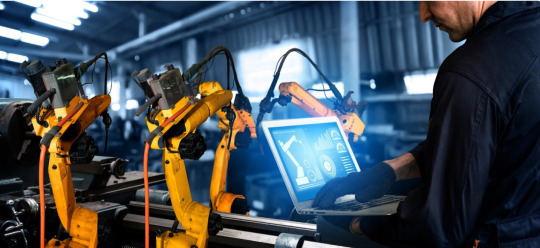
#Traceability Software Great Lakes Region#Machine Vision Integration Great Lakes#Great Lakes Industrial Marking Solutions#Factory Monitoring Software Great Lakes Region#Lean Manufacturing Solutions Great Lakes#Automated Data Collection Systems Great Lakes#Industrial Traceability Solutions Detroit#Machine Vision Systems Detroit#Detroit Barcode Verification Services#Laser Marking Services Detroit MI#Production Management Software Detroit#Detroit Manufacturing Systems#product traceability software Detroit#industrial marking systems Detroit#Laser Marking Services Auburn Hills#Industrial Traceability Solutions Michigan#Barcode Verification Systems Auburn Hills#Machine Vision Systems Michigan#Auburn Hills Laser Part Marking#Industrial Marking Solutions Michigan#Traceability Software Auburn Hills#Turnkey Laser Systems Michigan#Auburn Hills Barcode Reader Solutions#Advanced Laser Marking Auburn Hills MI#laser marking systems#laser marking machine#laser part marking#uv laser marking machine#uv laser marking#dot peen marking machine
0 notes
Text
Big Data and Data Engineering
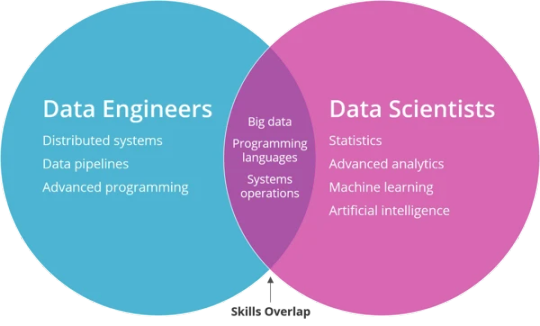
Big Data and Data Engineering are essential concepts in modern data science, analytics, and machine learning.
They focus on the processes and technologies used to manage and process large volumes of data.
Here’s an overview:
What is Big Data? Big Data refers to extremely large datasets that cannot be processed or analyzed using traditional data processing tools or methods.
It typically has the following characteristics:
Volume:
Huge amounts of data (petabytes or more).
Variety:
Data comes in different formats (structured, semi-structured, unstructured). Velocity: The speed at which data is generated and processed.
Veracity: The quality and accuracy of data.
Value: Extracting meaningful insights from data.
Big Data is often associated with technologies and tools that allow organizations to store, process, and analyze data at scale.
2. Data Engineering:
Overview Data Engineering is the process of designing, building, and managing the systems and infrastructure required to collect, store, process, and analyze data.
The goal is to make data easily accessible for analytics and decision-making.
Key areas of Data Engineering:
Data Collection:
Gathering data from various sources (e.g., IoT devices, logs, APIs). Data Storage: Storing data in data lakes, databases, or distributed storage systems. Data Processing: Cleaning, transforming, and aggregating raw data into usable formats.
Data Integration:
Combining data from multiple sources to create a unified dataset for analysis.
3. Big Data Technologies and Tools
The following tools and technologies are commonly used in Big Data and Data Engineering to manage and process large datasets:
Data Storage:
Data Lakes: Large storage systems that can handle structured, semi-structured, and unstructured data. Examples include Amazon S3, Azure Data Lake, and Google Cloud Storage.
Distributed File Systems:
Systems that allow data to be stored across multiple machines. Examples include Hadoop HDFS and Apache Cassandra.
Databases:
Relational databases (e.g., MySQL, PostgreSQL) and NoSQL databases (e.g., MongoDB, Cassandra, HBase).
Data Processing:
Batch Processing: Handling large volumes of data in scheduled, discrete chunks.
Common tools:
Apache Hadoop (MapReduce framework). Apache Spark (offers both batch and stream processing).
Stream Processing:
Handling real-time data flows. Common tools: Apache Kafka (message broker). Apache Flink (streaming data processing). Apache Storm (real-time computation).
ETL (Extract, Transform, Load):
Tools like Apache Nifi, Airflow, and AWS Glue are used to automate data extraction, transformation, and loading processes.
Data Orchestration & Workflow Management:
Apache Airflow is a platform for programmatically authoring, scheduling, and monitoring workflows. Kubernetes and Docker are used to deploy and scale applications in data pipelines.
Data Warehousing & Analytics:
Amazon Redshift, Google BigQuery, Snowflake, and Azure Synapse Analytics are popular cloud data warehouses for large-scale data analytics.
Apache Hive is a data warehouse built on top of Hadoop to provide SQL-like querying capabilities.
Data Quality and Governance:
Tools like Great Expectations, Deequ, and AWS Glue DataBrew help ensure data quality by validating, cleaning, and transforming data before it’s analyzed.
4. Data Engineering Lifecycle
The typical lifecycle in Data Engineering involves the following stages: Data Ingestion: Collecting and importing data from various sources into a central storage system.
This could include real-time ingestion using tools like Apache Kafka or batch-based ingestion using Apache Sqoop.
Data Transformation (ETL/ELT): After ingestion, raw data is cleaned and transformed.
This may include:
Data normalization and standardization. Removing duplicates and handling missing data.
Aggregating or merging datasets. Using tools like Apache Spark, AWS Glue, and Talend.
Data Storage:
After transformation, the data is stored in a format that can be easily queried.
This could be in a data warehouse (e.g., Snowflake, Google BigQuery) or a data lake (e.g., Amazon S3).
Data Analytics & Visualization:
After the data is stored, it is ready for analysis. Data scientists and analysts use tools like SQL, Jupyter Notebooks, Tableau, and Power BI to create insights and visualize the data.
Data Deployment & Serving:
In some use cases, data is deployed to serve real-time queries using tools like Apache Druid or Elasticsearch.
5. Challenges in Big Data and Data Engineering
Data Security & Privacy:
Ensuring that data is secure, encrypted, and complies with privacy regulations (e.g., GDPR, CCPA).
Scalability:
As data grows, the infrastructure needs to scale to handle it efficiently.
Data Quality:
Ensuring that the data collected is accurate, complete, and relevant. Data
Integration:
Combining data from multiple systems with differing formats and structures can be complex.
Real-Time Processing:
Managing data that flows continuously and needs to be processed in real-time.
6. Best Practices in Data Engineering Modular Pipelines:
Design data pipelines as modular components that can be reused and updated independently.
Data Versioning: Keep track of versions of datasets and data models to maintain consistency.
Data Lineage: Track how data moves and is transformed across systems.
Automation: Automate repetitive tasks like data collection, transformation, and processing using tools like Apache Airflow or Luigi.
Monitoring: Set up monitoring and alerting to track the health of data pipelines and ensure data accuracy and timeliness.
7. Cloud and Managed Services for Big Data
Many companies are now leveraging cloud-based services to handle Big Data:
AWS:
Offers tools like AWS Glue (ETL), Redshift (data warehousing), S3 (storage), and Kinesis (real-time streaming).
Azure:
Provides Azure Data Lake, Azure Synapse Analytics, and Azure Databricks for Big Data processing.
Google Cloud:
Offers BigQuery, Cloud Storage, and Dataflow for Big Data workloads.
Data Engineering plays a critical role in enabling efficient data processing, analysis, and decision-making in a data-driven world.
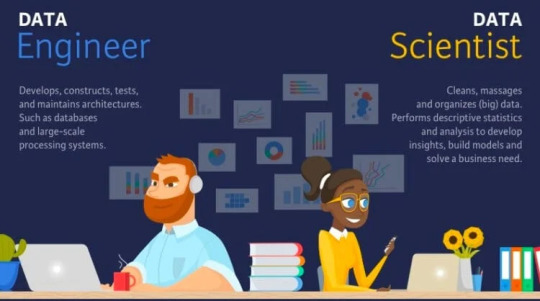
0 notes
Text
The Future of Water Management: A Deep Dive into Water Level Automation
Introduction
Water is a precious resource that is vital for our survival, and efficient water management is crucial to ensure its sustainable use. With the increasing stress on global water resources due to population growth and climate change, innovative solutions are needed to optimize water usage. One such solution that holds immense promise is water level automation. In this blog, we will explore the future of water management through the lens of water level automation.
The Growing Need for Water Management
Water is essential for various purposes, including drinking, agriculture, industrial processes, and ecological balance. As our population continues to grow and climate change disrupts traditional weather patterns, the need for effective water management becomes increasingly urgent.
In many regions, water scarcity is a pressing issue, with water levels in reservoirs, rivers, and aquifers fluctuating unpredictably. Mismanagement of water resources can lead to devastating consequences such as droughts, water shortages, and even conflicts over water rights. To address these challenges, we must turn to technology for innovative solutions, and water level automation offers a promising path forward.
What is Water Level Automation?
Water level automation refers to the use of technology to monitor and control water levels in various systems, such as reservoirs, tanks, and irrigation systems. This automation relies on a combination of sensors, actuators, and control systems to ensure that water is distributed efficiently and wastage is minimized.
Key Components of Water Level Automation
Sensors: Water level sensors are the heart of any automation system. These sensors can be ultrasonic, pressure-based, or float switches, and they measure water levels accurately in real time.
Control Systems: Control systems process the data collected by the sensors and make decisions about when to open or close valves, pumps, or gates to regulate water flow.
Actuators: Actuators are the devices that physically control the flow of water. They can be valves, pumps, or gates that respond to the commands of the control system.
Advantages of Water Level Automation
Resource Optimization: Water level automation ensures that water is used efficiently, reducing wastage and conserving this precious resource.
Energy Efficiency: By automating pumps and valves, water level automation minimizes the energy required to maintain water levels, saving both energy and operational costs.
Data-Driven Decision Making: The data collected by the system provides valuable insights for better decision-making and long-term planning.
Reduced Labor Requirements: Automation reduces the need for constant manual monitoring and adjustment, freeing up human resources for more complex tasks.
Applications of Water Level Automation
Agriculture: Automated irrigation systems can help farmers optimize water usage, resulting in better crop yields and water conservation.
Municipal Water Supply: Water utilities can manage reservoirs and distribution systems more effectively, ensuring a stable water supply for communities.
Industrial Processes: Industries that require precise water levels, such as those in manufacturing or mining, can benefit from automation to reduce production downtime and save water.
Environmental Monitoring: Water level automation is crucial for monitoring and managing the water levels of natural ecosystems, such as wetlands and lakes.
Challenges and Considerations
While water level automation holds great potential, it is not without challenges. Initial setup costs, the need for maintenance, and potential cybersecurity risks are considerations that must be addressed. Additionally, the technology needs to be accessible and affordable for smaller communities and developing regions to truly make a global impact.
The Future of Water Level Automation
As technology continues to advance, the future of water level automation looks promising. Integration with the Internet of Things (IoT), artificial intelligence, and machine learning will enable even more sophisticated control and predictive capabilities. This will make water management more precise, efficient, and adaptable to changing conditions.
Conclusion
Water level automation represents a vital step towards ensuring the sustainable use of water resources in an ever-changing world. As the global population grows and climate change continues to impact our environment, efficient water management is not only a practical solution but a moral imperative. By embracing technology and innovation, we can look forward to a future where water is managed intelligently, ensuring a reliable supply for all while preserving this precious resource for generations to come.
1 note
·
View note
Text
The Privacy Paradox in the Information Economy and the age of Digital Sovereignty
Reflections and Learnings After Collecting and Exploiting Personal Data of Millions of Users in Latin America.

Introduction
Wifers, the company I co-founded in Argentina in 2016, was the result of a process of building on previous experiences together with a unique industry context. Having previously led e-commerce and digital identity projects, it seemed clear to me that the next step would be a convergence between the digital and physical worlds. The vision was to transfer the knowledge and tools acquired by digital businesses during the boom of e-commerce a few years before to physical stores, which still represented over 90% of total commerce. By using hardware and software to collect information at the point of sale, we would be able to bridge the gap between online and offline commerce.

Initially, our focus was on generating a simple and affordable solution for small bistros to capture information from customers visiting their stores using Wi-Fi access points. In following iterations, we offered these businesses the opportunity to target and automate their customer communications, aiming to enhance customer engagement and retention. Finally, once we had a significant network of locations, we embarked on a data analysis challenge leveraging behavioral insights, customer preferences, recurrence, and walk-through metrics at the point of sale. We could even detect when a social media influencer walked in. By the beginning of 2020, our solution had been deployed in hundreds of stores across six countries in the region and our client base expanded to include pharmaceutical companies, multinational corporations and governments.
During that period, the industry underwent significant changes, including advancements in privacy and personal data protection regulations, updates in mobile operating systems and multiple devaluations of the Argentine peso. Ultimately, the pandemic forced us to stop our operations, interrupting an acquisition process with a US company that we had been negotiating with for over a year. Some of the operational and strategic decisions that left valuable lessons can be covered in another article. For now, I would like to share some insights on privacy in the information economy. The case of Wifers and other similar companies is relevant because it was enabled by three simultaneous phenomena: the privacy paradox, opacity vs. transparency and regulatory gaps.

Presenting Wifers at Start-Up Chile G21 Demo Day (Santiago de Chile, 2019)
The Privacy Paradox
In his 1944 book “The Great Transformation”, Hungarian-American economist Karl Polanyi described the commoditization of essential elements of society that propelled the rise of industrial capitalism:
The idea of taking “human activity” outside the market, bringing it into the market, labeling it as labor and assigning it a price;
The idea of bringing elements of “nature” such as lakes, trees, and land into the market, calling it real estate and assigning it a price;
And the idea of “exchange”, which, subordinate to the market, has become the concept of money.
The great discovery of the 21st century is the notion that we can bring “human experiences” into the market, calling it data and then buy, sell, or create new markets for targeted advertising, personalization and profit generation. For several years now, data is the new commodity fueling the rise of surveillance capitalism, a new economic paradigm based on the intrusion into individuals’ privacy through digital technologies. The rapid and widespread adoption of these technologies and data collection practices have made it challenging for individuals to fully understand and control their privacy invasion. We can take the example of ‘Threads”, recently launched by Meta. How many users who were pulled from Instagram to this new app are aware of the amount of data it is collecting? How many are wondering why they really need all this information for an ordinary public messaging application?
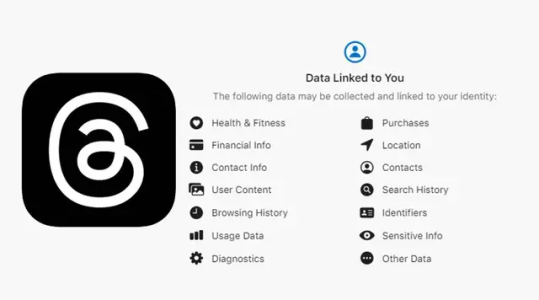
The data collected by the Threads app could include your sexual orientation, race and ethnicity, biometric data, trade union membership, pregnancy status, politics and religious beliefs.
Even acknowledging this, why individuals feel compelled to trade their personal data for access to certain products and services? The privacy paradox explains this disconnect between people’s concerns about privacy and their actual behaviors, attributed to several factors: asymmetry of power (individuals feel helpless or resigned against large corporations and believe their privacy is already compromised), convenience (people will overlook privacy concerns in exchange of benefits and personalized services), lack of awareness and understanding of data collection practices, social influence and norms (observing others willingly sharing personal information without negative consequences influence them to do the same) and timing (people prioritize immediate gratification over long-term privacy considerations when making decisions).
“The sharing of personal information might be perceived as a loss of psychological ownership that threatens individual’s emotional attachment to their data.”
Back in 1944, Polanyi argued that the unrestricted marketization of key commodities can have detrimental social and environmental consequences, contending that society must establish protective measures and institutions to counterbalance the potentially harmful effects of unregulated markets. In the information economy, understanding the privacy paradox is crucial for policymakers, organizations and individuals, and it highlights the urgent need for transparent data practices, user-friendly privacy policies and improved education regarding privacy risks.
Opacity vs. Transparency
Despite having fully capitalized on the privacy paradox, we always upheld ethical practices when it came to storing, managing, and being transparent with user data policies for those connecting to our systems. Throughout my period as the company’s director, no data was compromised, sold or transferred to third parties, either directly or indirectly. I firmly believed that if we were the ones processing the information, we should be the ones capable of monetising it in the most transparent and ethical way possible.
However, increased data volume meant more value for the company, driving the constant need to find new ways of extracting information from individuals through new sources and processing techniques. In order to achieve many of our functionalities, we needed to rapidly and seamlessly collect data on millions of people, and many of these data collection techniques operated opaquely, in the background. For instance, users were often unaware that we could detect their devices in stores, even when not connected to our Wi-Fi networks or when their devices were locked, despite it being stated in our terms and conditions.

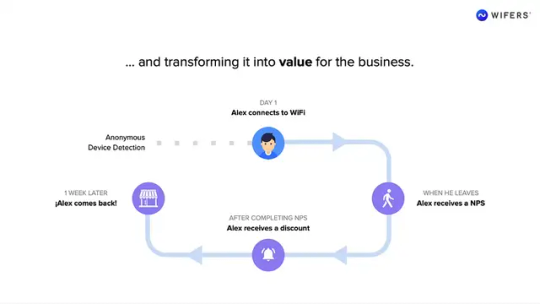
The dilemma of opacity and transparency is not new in the history of information systems but becomes particularly sensitive when a company’s existence is directly tied to the quantity and quality of the data it utilizes. Products like Threads and Wifers can take advantage of opacity to find new data collection opportunities because their business relies on it. Maintaining transparency policies requires significant effort. In the information economy, the pursuit of data as a commodity can blur ethical boundaries and lead companies to overlook this in order to maximize profits, potentially resulting in privacy violations, data misuse and other significant problems.
Regulatory Gaps
In a familiar pattern from previous experiences, we entered the market early. Not only did we secure our first sales before companies even realised they needed our technology, but we also operated silently for a significant period of time, employing a small organizational structure and employing seemingly invisible technology. This ability to remain unobserved provided us with a competitive advantage, but it was also facilitated by the context. These transactions existed in a regulatory vacuum, devoid of oversight, audits, or comprehensive protection measures.
Across the numerous locations and countries where we operated in Latin America, there existed (and still exists) no clear-cut regulatory framework that establishes the boundaries within which companies can collect and exploit personal data belonging to their customers. Our business model would have encountered very different challenges in the United States or Europe, where online privacy and personal data have been subject to legislation since 2016. Instead, we thrived for years in a green field facilitated by regulatory gaps.
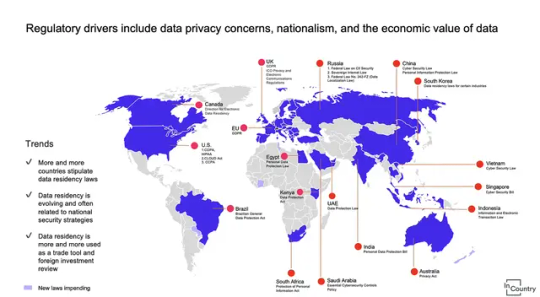
The progress made in data legislation worldwide in 2021 represents a significant milestone in the ongoing fight for internet freedom and individual protection (InCountry, 2021)
Fortunately, privacy regulations are evolving slowly but surely. Leading the way is the European Union with its robust General Data Protection Regulation (GDPR), setting a high standard for data protection and inspiring other jurisdictions to update or establish their own data privacy laws. In an environment where privacy concerns are growing, the evolving landscape of privacy regulations worldwide may signify a shift towards consumer protection.
The age of digital sovereignty
Companies like Wifers were possible a few years ago, but may not be viable today. It is no coincidence that Threads has not yet been launched in Europe. The resistance against surveillance capitalism, fueled by the dominance of digital advertising giants in the Web 2 era and signed by the Facebook-Cambridge Analytica scandal, has raised awareness and sparked a strong desire among consumers and developers to challenge and weaken the data aggregation practices of corporations and governments.
More educated and privacy-conscious consumers, developers creating more transparent alternatives and regulated environments are paving the way for a transformative shift in the digital landscape. As this new paradigm takes shape, a vision is emerging for the Web 3 as a decentralized future that respects privacy, protects autonomy, and challenges power distribution. Some of this alternatives could truly disrupt the dominance of major players and restore digital sovereignty to individuals. For example, promising technologies like Self-Sovereign Identity (SSI) or decentralized identity are offering new ways to protect personal data and reshape the landscape in technical, commercial, legal, and social dimensions.
The path ahead is long, but the destination is clear. Our personal information and experiences must belong to us once again, and the internet should fulfill its promise as a tool for connection and democratization.
0 notes
Text
AI CITY Will Pave the Way For the Cities of Tomorrow
Cities often represent growth in mankind’s collective wisdom. The goal of every great city is to be built with the highest quality resources available and make use of the newest and most innovative technologies.
In the ancient city of Rome in the 1st century AD, the use of early hydro technologies allowed the population to flourish. Hydro power was one of the most widely used examples, generating mechanical energy through massive waterwheels. Furthermore, a highly developed water supply and drainage system provided ample clean water every day. They would collect the water and store it in large reservoirs by redirecting subsurface water from nearby rivers and lakes into artificial channels called ‘aqueducts’. This system was so effective that their water supply actually exceeded population demand. It was able to support households, gardening, water shows, mill grinding and the great Roman fountains we still see in use today. The Romans could even use the waterways as escape routes or in complex military strategies.
These innovations were magnificent. They laid the foundation for the incredibly rich, vibrant cities we live in today. Over 2,000 years later, our idea of innovation has shifted. Instead of aqueducts, we are working with the invisible networks of 5G, big data, Internet of Things (IoT) and artificial intelligence (AI).
Let’s set the stage. Morning sunbeams stretch slowly over a city silhouette, as the light reaches out into every corner of this X-Tech city. The residential roads are bordered by lush greenery as dewdrops slide from the highest tree leaves down onto solar panel laden rooftops, then to their final resting place in the grass. There is a heartbeat - not just within the surrounding nature - but witihin the structures themselves. As the dewdrops fall, the solar panels adjust themselves, ever so slightly, so water can slide into the gutters and reach the plants below. As sunlight hits the houses, bedroom windows adjust their opacity to allow the natural light to wake sleepy residents. Once light has filled the room, an AI virtual housekeeper selects your breakfast, matches your outfit with the weather, and presents a full schedule of your day. After breakfast, you step into your intelligent, fully-automated vehicle, and begin your intercity commute cities browsing global market news - recommended by an algorithm, of course!
This is not some SciFi pipedream, but a glance at the plans for an upcoming AI CITY. As early as 1992, Singapore proposed an plan known as the "Intelligent Island" in an attempt to create a country powered by artificial intelligence and machine learning. Subsequently, the Korean government proposed the "U-Korea" strategy in 2004, hoping to use the Internet and wireless sensors to transform Korea into a smart society.
In 2008, IBM first proposed the "Smarter Planet” initiative, and then formally rolled out the concept of "Smarter Cities" in 2010. Since then, there has been momentum toward creating "smart cities" around the world.
In 2013, the Ministry of Industry and Information Technology of China led the establishment of the China Smart City Industry Alliance and planned to invest RMB 500 billion in the next few years to build smart cities. In 2015, the US government proposed a new smart city initiative to actively deploy smart grids, smart transportation and broadband.
Cities are effectively giant machines that must run 24/7. People need this machine in excellent working order every day to protect and transport people and resources for different purposes – big and small. These tasks range from keeping public order to repairing broken manhole covers. Smart cities seek to connect all these details of city life to the Internet and Cloud, applying IoT, AI, 5G, big data and other new ICT technologies to optimize operational efficiency of these giant machines.
The AI CITY is the next generation smart cities, and its scope is more sophisticated than merely connecting devices. The key innovation lies in the role of artificial intelligence in its infrastructure, which will allow devices to operate on their own. This will ultimately allow the city to better manage its people and resources.
Europe and the United States had an early start in the development of smart cities. In London, investments in smart city infrastructure such as the Internet of Things, big data, cloud computing, artificial intelligence and blockchain have reached GBP 1.3 trillion. These investments were largely used in building smart grids, smart streets, smart transportation and other municipal projects. As an example, let’s look at London’s West End. Using GIS, CAD and 3D virtual technology, the area has been transformed into a hub of data generating buildings. Around 45,000 buildings within an area of nearly 20 sq.km are now utilizing internet-connected, data-generating devices in the West End. It’s a prime example of an urban geo-information system offering optimized looks into landscape design, traffic control, sustainability, emergency management and more.
New York has also benefited from a smart urban technology. More specifically, the city implemented a smart grid project where Con Edison, an electricity utilities company, automated and upgraded more than one-third of New York’s power grid to prevent any single accident from causing damage to the entire grid.
Moving geographies, the number of smart city developments in the East have outpaced the West. Both Japan and South Korea have used smart city technology to focus on resource allocation in their most densely populated cities. Seoul has established an integrated transportation system that uses smart cameras in subways to obtain information on passenger volume, and adjust the speed and frequency of trains in real time accordingly. It also installed sensors to monitor important train components to proactively prevent malfunctions. In Yokohama, the Smart Environment Project has deployed a series of advanced energy management systems in households and commercial buildings to "visualize" energy. Solar power solutions and home energy management systems were installed which allowed crucial energy data to be displayed. Now municipal officials could track power generation, power consumption and power sales.
Currently, China enjoys the fastest development of smart cities and has the highest abundancy of smart communities and AI technology in the world. More than 40% of global smart city projects are currently under construction in China. In Chongqing, a metropolis in southwest China, Terminus - an innovator in artificial intelligence, internet of things, and robotics - is building a smart city with a total gross floor area of 2,500,000 sqm. The company plans to use its suite of AI and IoT technologies to upgrade the sustainability, operations and visitor experience of the city. It will also empower traditional industries with new ICT technologies to create the world's first model of an AI CITY which incorporates all types of businesses and diversified industrial chains.
The Catalyst for AI CITY Implementation: Competition among the World's Top Tech Companies
Although the government plays an important role in planning and building an AI CITY, the true drivers of smart city innovation are the world's top technology companies.
IBM, the first major player in the smart city space, applied different functional modules such as smart healthcare, smart transportation, smart education, smart energy, and smart telecommunication to hundreds of cities across the globe. It collected a large quantity of data and integrated it into the city's main operational management centers.
However, given that cloud computing and AI technologies were not salient during this period, IBM was not able to effectively roll out its “Smarter Cities” initiative. Its solutions were frequently turned down by municipal governments due to the immense investment costs overshadowing the benefits gained from the new technology.
As a world-renowned network provider, Cisco has developed another angle on smart cities. Instead of undertaking mammoth projects like integrating smart technology across entire cities, Cisco’s strategy focuses on establishing smaller smart communities and driving change from the bottom up. In Copenhagen, it helped the city become carbon neutral; in Hamburg, it played a role in establishing a fully digital network and IT strategy that enabled an integrated management of land and marine transportation.
Meanwhile, Siemens, a global leading industrial manufacturer, has been working on smart grid solutions to help cities optimize their energy storage. Centralizing their strategy around smart grids allows for meaningful connections between smart buildings, electric transportation, smart meters, power generation, etc. It allows the company to integrate and upgrade an existing system as opposed to building out an entirely new system from scratch. It is an effective way to test out the new IoT technologies without generating tremendous risk to the city’s existing infrastructure.
The AI CITY ecosystem in China has benefitted tremendously from these existing projects. Chinese companies have been able to learn from the development of these global projects and combine the existing frameworks with emerging technologies like 5G, big data, cloud computing, AI and intelligent hardware R&D. This has provided an edge when constructing new smart city projects domestically.
Terminus, a leading global smart service provider, is one company taking full advantage of this opportunity. Terminus aims to shape the next generation of technology with AI and IoT, and has emerged as an industry integrator, achieving full coverage from a suite of products from service robots and sensors to edge smart products, all the way to cloud platforms. Terminus’ AI CITY solution is scene-oriented. It utilises the company's many years of experience in the AIoT industry to bring solutions for social management, energy efficiency improvement, smart parks, cultural innovation and smart finance to communities and cities. It has implemented and maintained more than 8,000 smart scenes in 84 cities.
Terminus’ AI CITY smart solutions are used to enhance traditional offline spaces. Shopping malls, for example, have several areas where operational efficiency could be better optimized. Terminus’ smart solutions allow malls to find these optimal points by collecting multi-dimensional data related to people, goods, stores, and orders. Their solutions provide digital operational tools for each functional unit of the mall. This allows customers to have a more reliable and enjoyable shopping experience. As an added benefit, by tapping into rich data, the shopping mall is able to achieve higher sales conversion, higher per capita sales and higher inventory turnover.
Terminus’ intelligent fire protection solution tells another positive story in favour of developing smart technologies. Terminus is able to leverage artificial intelligence to create a system of automated fire prevention and control. It lowers risk to firefighters and law enforcement while increasing preventative measures for structure fires. Terminus uses GPS, GIS, BIM and other geographic location information systems to map firehouses and fire law enforcement units in real-time. As a result, responders can reach the scene more efficiently by triangulating the closest available units. This solution also provides tooling for conducting data queries, pulling statistics, general analysis, decision-making, and intelligent identification of fire origins. The information is stored in data warehouses which can be mined and analyzed as needed.
Unlike the bottom-up strategies that other technology companies have used to promote smart city construction, Terminus has taken a top-down approach for scaling their solutions. Terminus aims to build science and technology industry parks by integrating its industrial resources. It also aims to enrich and improve its solutions by exploring diverse use cases. By continuing to grow within local smart city operations, Terminus has seized an opportunity to shape core frameworks for future smart cities. It stands to profit from the growing demand for smart technologies, while also contributing to a more sustainable world.
What Else Can We Do to Find the Way to AI CITY
The map to a sustainable AI CITY is unfolding at an unprecedented rate. Two players will influence the continued development of smart cities: governments and industry-leading companies.
For governments, it is essential to support in the planning and development of an AI CITY. Most importantly, they must consider the opinions and well-being of their citizens. London is an excellent example. The Greater London Authority developed an online community called "Talk London" to provide a safe space for online discussion, voting, Q&A, surveys, and more to cover impactful topics ranging from private rental markets to the safety of cyclists around large trucks. This process allows London citizens to participate in government decision-making. As a result, the policies formulated by the government often more accurately reflect the real needs of its people. In comparison, Google's Toronto Smart City Plan was recently under fire as it went against the needs of the local residents.
In closing, it would seem industry-leading companies will be tasked with shouldering more social responsibility. There is a clear commitment from these entities to contribute to technological progress, cultivate highly skilled professionals, and grow their brand. However, there is a crucial role to be played in popularizing and building out legitimate use cases for these new cities. These companies must extend the range of their considerations beyond just technology to those that will be using it. Innovation comes with the innate responsibility to better the lives of people around the globe. If the smart city and AI CITY models can embrace this notion, the future will be brighter than ever before.
https://www.terminusgroup.com/ai-city-will-pave-the-way-for-the-cities-of-tomorr.html

1 note
·
View note
Text
Maximize Efficiency with Track-Pac Traceability Solution
Stay ahead in production with customizable tools built for precision. Discover how Track-Pac Traceability Solution can help!
#advanced laser marking auburn hills mi#auburn hills laser part marking#automated data collection systems great lakes#detroit barcode verification services#Track-Pac Traceability Solution
0 notes
Text
How to Pass Microsoft Azure Foundation Exam AZ-900 (Part 2 of 3)
The Microsoft Azure Foundation Exam AZ-900 or the equivalent from AWS are usually the first cloud certificates that someone new to the cloud starts with. Both cover basic cloud concepts and ensure that you gain a profound understanding of the respective services. As the passing grade of 80% for the AZ-900 is quite high, it is advisable to thoroughly study for the exam. This is the first of three posts that will provide you with all key information about the Azure services that you need to pass the Azure Foundation Exam AZ-900.
The following structure is taken from the latest exam syllabus for the Azure Foundation 2021 and indicates the weight of each chapter in the exam. For each chapter, I have written down a very brief summary of key concepts and information that are typically asked for during the exam. The summary is a great resource to check and finalize your studies for the exam. However, if you are new to the topic, you should first start by going through the official Microsoft Azure training materials.
This is part 2 of the three-parts series regarding the Microsoft Azure Foundation exam AZ-900 and it will cover the third and fourth topic from the content below:
1. Describe Cloud Concepts (20-25%)
2. Describe Core Azure Services (15-20%)
3. Describe core solutions and management tools on Azure (10-15%)
3.1 Describe core solutions available in Azure
3.2 Describe Azure management tools
4. Describe general security and network security features (10-15%)
4.1 Describe Azure security features
4.2 Describe Azure network security
5. Describe identity, governance, privacy, and compliance features (20- 25%)
6. Describe Azure cost management and Service Level Agreements (10- 15%)
3. Describe core solutions and management tools on Azure (10-15%)
3.1 Describe core solutions available in Azure
Virtual Machines
A virtual machine is an IaaS service. Administrators from a company would have full control over the operating system and be able to install all applications on it. For example, Virtual machines can have a VPN installed that encrypts all traffic from the virtual machine itself to a host on the Internet. They can also transfer a virtual machine between different subscriptions.
Scale sets help to manage increased demands, load balancer help to distribute user traffic among identical virtual machines. Azure Virtual Machine Scale Sets are used to host and manage a group of identical Virtual Machines.
To avoid failure in case that a data center fails, you need to deploy across multiple availability zones. At least two virtual machines are needed to ensure 99.99% up time. If a virtual machine is switched off, there are no costs for processing, but still for storage services.
Containers
Containers are more lightweight than virtual machines. Instead of virtualizing the complete operating system, they only need the images and libraries and access the underlying operating system from the host environment. Multiple containers are managed with Azure Kubernetes, which is an IaaS solution.
Storage
Data disks for virtual machines are available through blob storage. Blob storage costs depend on the region. Storage costs depend on the amount of stored data, but also on the amount of read and write operations. Transfers between different regions also costs.
An Azure Storage account – file service – can be used to map a network drive from on premise computers to a Microsoft Azure storage.
Cool storage and archive storage can be used for data that is infrequently accessed.
Further Azure Services
Azure SQL database is a PaaS service. Companies buying the service would not have control over the underlying server hosting in Azure
Azure Web App is a PaaS solution, accessible via https://portal.azure.com. One would not have full access on the underlying machine hosting the web application
Azure DevOps is an integration solution for the deployment of code. It provides a continuous integration and delivery toolset
Azure DevTestLabs quickly provides development and test environments, such as 50 customized virtual machines per week
Azure Event Grid can collect events from multiple sources and process them to an application
Azure Databricks is a big data analysis service for machine learning
Azure Machine Learning Studio can be used to build, test, and deploy predictive analytics solutions
Azure Logic Apps is a platform to create workflows
Azure Data Lakes is a storage repository holding large amounts of data in its native, raw format
Azure Data Lake Analytics helps to transform data and provide valuable insights on the data itself
Azure SQL Data Warehouse is a centralized repository of integrated data from one or more sources. It requires zero administration of the underlying infrastructure and provides low latency access to the data
Cosmos DB Service is a globally distributed, multimodal database service. It can host tables and json documents in Azure without required administration of the underlying infrastructure
Azure Synapse Analytics is an analytics service that brings together enterprise data ware housing and Big Data Analytics
Azure HD Insight is a managed, full-spectrum, open-source analytics service. It can be used for frameworks such as Hadoop, Apache etc
Azure Functions App and Azure Logic App are platforms for serverless code. Azure Logic focuses on workflows, automation, integration, and orchestration, while Azure Functions merely executes code
Azure App Services hosts web apps / web-based applications. It requires to manage the infrastructure
Azure Marketplace is an online store that offers applications and services either built on or designed to integrate with Azure
IoT Central provides a fully managed SaaS solution that makes it easy to connect, monitor, and manage IoT assets at scale
IoT Hub can be used to monitor and control billions of Internet of Things assets
IoT Edge is an IoT solution that can be used to analyze data on end user devices
Azure Time Series Insights provides data exploration and telemetry tools to help refine operational analysis
Azure Cognitive Services is a simplified tool to build intelligent Artificial Intelligence applications
3.2 Describe Azure management tools
Azure Applications Insights monitors web applications and detects and diagnoses anomalies in web apps
The Azure CLI, Azure Powershell, and Azure Portal can be used on Windows 10, Ubuntu, and macOS machines
Cloud Shell works on Android or MacOS that has Powershell Core 6.0 installed
Windows PowerShell and Command Prompt can be used to install the CLI on a computer
4. Describe general security and network security features (10-15%)
4.1 Describe Azure security features
The Azure Firewall protects the network infrastructure
The Azure DDoS Protection provides protection against distributed denial of service attacks
Network Security Groups restrict inbound and outbound traffic. They are used to secure Azure environments
Azure Multi-Factor Authentication provides an extra level of security when users log into the Azure Portal. It is available for administrative and non-administrative user accounts
The Azure Key Vault can be used to store secrets, certificates, or database passwords etc.
Azure Information Protection encrypts documents and email messages
Azure AD Identity Protection can make users that try to login from an anonymous IT address to need to change their password
Authentication is the process of verifying a user´s credentials
4.2 Describe Azure network security
A Network Security Group can filter network traffic to and from Azure resources in an Azure virtual network. They can also ensure that traffic restrictions are in place so that a database server can only communicate with the web browser
An Azure Virtual Network can provide an isolated environment for hosting of virtual machines
A Virtual Network Gateway is needed to connect an on-premise data center to an Azure Virtual Network using a Site-to-Site connection
A Local Network Gateway can represent a VPN device in the cloud context
0 notes
Text
How does data science help start-up post-2020

Technology has grown by miles in recent years, which has prompted businesses to utilize it to the fullest for their growth. However, with technology, a significant amount of data is getting generated. Getting valuable and actionable insights from the data has thus become difficult. This is where data science comes into the picture for businesses across verticals. Even when we talk of startups, data scientists need to create architectures from scratch.
Data scientists have to perform multiple tasks in a startup like identifying key business metrics, understanding customer behaviour, developing data products, and testing them for their efficiency. Let us understand in detail how data science can help startups in 2020.
Why is data science important even for non-tech startups?
With the increasing competition in the business space, it has become more important than ever for organizations to master the art of personalization. Though serving the customers at the start of the journey remains a challenge, scaling up the business eventually is more challenging. Data science can help entrepreneurs ramp up their personalization efforts. Retail buyers’ persona can be identified and created based on their shopping history. This serves businesses to showcase to new customers what other people have seen, based on similar preferences. It helps in making informed recommendations.
How can startups implement data science in their business?
Rather than having data science integrated at the organizational level, it must be integrated at the team level. This includes different teams like sales, marketing, product, etc. Businesses must look forward to giving the data to the data scientists in an appropriate format so they can work efficiently.
It will be an ineffective process if companies just dump the data in the systems of data scientists. With data in a single format, businesses can give a data lake. It will bring in efficiency and make data scientists more productive. Let us have a look at the various stages of data science in startups.
Data Extraction and Tracking
As the first step, it is important to collect data that needs analysis at a later stage. Before proceeding ahead, you must identify the customer persona and user base. If you run an ed-tech startup and want to develop an app, you must identify how likely would its usage be. You must identify the number of users who will install the app, what would be the number of active sessions, and how likely will they spend.
This makes it important to collect the data on these parameters to identify the user base of your app. It is also essential to add specific attributes regarding product usage. Doing so will also help you identify the users who are most likely to opt-out of services and ways to prevent that.
Creating Data Pipelines
Being the second step in the process, you must analyze and process the data to gain relevant insights. It is the most important step that needs careful analysis. This helps data scientists to analyze the data from the data pipeline. It usually remains connected to a database, either an SQL or Hadoop platform.
Product Health Analysis
Data scientists need to analyze the metrics, which indicates the product’s health. Using raw data to transform it into usable data that shows the health of the products is a vital function of data scientists. Businesses can identify the product’s performance through these metrics. Several tools help data scientists perform this process. ETLs (extract, transform and load), R, and KPIs are some key metrics to analyze the product performance.
Exploratory Data Analysis
Exploring the data and gaining crucial insights is the next step after establishing a data pipeline. Data scientists can understand the data’s shape, the relationship between different features, and also gain insights about the data.
Creating predictive models
With the help of machine learning, data scientists can make predictions and classify the data. One of the best tools to forecast the behaviour of a user is predictive modelling. It helps businesses identify how well the users will respond to their product. Startups offering recommendation systems can create a predictive model to recommend products and services based on a user’s browsing history.
Building Products
Building products centred on data can help startups improve their offerings. This can be done when data scientists move from training to deployment. This is possible by using different tools to create new data products. Identifying the operational issues might not be possible every time. This can be overcome by manifesting data specifications on an actual product. It can handle data-related issues and prove beneficial for the startup.
Product Experimentation
Before introducing changes in a product, startups must conduct an analysis to identify their benefits. They need to identify if customers will accept and embrace the change. A/B testing is one of the common experimentation tools. You can draw a statistical conclusion when conducting hypothesis testing to compare the different variable versions. One of the limiting factors of A/B testing is the inability to control the users of different groups.
Data science and automation
Strenuous and repetitive tasks can easily get replaced with the help of data science. The cost reduction here can prove beneficial for utilization in other areas. This will help startups utilize their resources productively. So it will not reduce jobs but will give startups the chance to get better ROI from their employees. With increased productivity, startups can scale their operations faster. The available capital can complement the growth and increase their operational capacities.
Final Thoughts
Data science can help startups improve their product offerings and scale operations. The importance of data science is huge, as data is the lifeline of startups. As the demand for skilled data scientists is on the rise, Great Learning can help you learn data science. If you opt for a data science program, it will help you understand big data analytics, predictive analytics, neural network, and much more.
One of the excellent learning sources, these data science courses can give you a comprehensive learning experience. You can opt for a Python data science course, data scientist course, or even data science online training. Get in touch with us today to know more details about the courses and admission process.
0 notes
Text
Data Science & AI Trends In India To Watch Out For In 2020 | By Analytics India Magazine & AnalytixLabs

The year 2019 was great in terms of analytics adoption as the domestic analytics industry witnessed a significant growth this year. There has been a visible shift towards intelligent automation, AI and machine learning that is changing the face of all major sectors — right from new policies by the Indian Government, to micro-adoption by startups and SMEs. While customer acquisition, investment in enterprise-grade data infrastructure, personalised products were some of the trends from 2018, this year our industry interaction suggested that democratisation of AI, AI push into hardware and software are much talked about. Our annual data science and AI trends report for the upcoming year 2020 aims at exploring the key strategic shifts that enterprises are most likely to make in the coming year to stay relevant and intelligent. This year we collaborated with AnalytixLabs, a leading Applied AI & Data Science training institute to bring out the key trends. Some of the key areas that have witnessed remarkable developments are deep learning, RPA and neural networks which, in turn, is affecting all the major industries such as marketing, sales, banking and finance, and others. Some of the most popular trends, according to our respondents, were the rise in robotic process automation or hyper-automation that has begun to use machine learning tools to work effectively. The rise in explainable AI is another exciting development that the industry is likely to see in the popularity charts in the coming year, along with the importance of saving data lakes and the rise of hyperscale data centres, among others. Some of the other trends like advancements in conversational AI and augmented analytics, are here to stay. Semantic AI, enterprise knowledge graphs, hybrid clouds, self-service analytics, real-time analytics and multilingual text processing were some of the other popular trends mentioned by the respondents which are likely to be on the rise in 2020.

01. The Rise Of Hyper-Automation

"2019 has seen rising adoption of Robotic Process Automation (RPA) across various industries. Intelligence infused in automation through data science and analytics is leading to an era of hyper-automation that enables optimization and modernisation. It is cost-effective too but may have risks. 2020 will see enterprises evaluating risks and control mechanisms associated with hyper-automation."Anjani Kommisetti, Country Manager, India & SAARC

"Hyper-automation uses a combination of various ML, automation tools and packaged software to work simultaneously and in perfect sync. These include RPA, intelligent business management software and AI, to take the automation of human roles and organizational processes to the next level. Hyper automation requires a mix of devices to support this process to recreate exactly where the human employee is involved with a project, after which it can carry out the decision-making process independently."Suhale Kapoor, Executive VP & Co-founder, Absolutdata

"Automation is going to increase in multitudes. Over 30% of data-based tasks will become automated. This will result in higher rates of productivity and analysts will have broader access to data. Automation will additionally assist decision makers to take better decisions for their customers with the help of correct analytics." Vishal Shah, Head of Data Sciences, Digit Insurance 02. Humanized Artificial Intelligence Products

"We will see AI getting deeper into Homes and lifestyle and Human Interaction would begin to increase in the coming year. This means a reliable AI Engine. We have already seen some voice based technology making a comfortable place in homes. Now, with Jio Fiber coming home and Jio disrupting telecom sector it will be interesting to see how the data can be leveraged to improve/ develop devices that are more human than products." Tanuja Pradhan, Head- Special Projects, Consumer Insights & New Commerce Analytics, Jio

"Rise of AI has been sensationalised in the media as a battle between man and machine and there are numerous numbers flying around on impact on job loss for millions of workers globally. However, only less than 10% of roles will really get automated in the near future. Most of the impact is rather on non-value-added tasks which will free-up time for humans to invest in more meaningful activities. We are seeing more and more companies releasing this now and investing in reskilling workforce to co-exist with and take advantage of technology." Abhinav Singhal, Director, tk Innovations, Thyssenkrupp

"The effects of data analysis on vast amounts of data have now reached a tipping point, bringing us landmark achievements. We all know Shazam, the famous musical service where you can record sound and get info about the identified song. More recently, this has been expanded to more use cases, such as clothes where you shop simply by analyzing a photo, and identifying plants or animals. In 2020, we’ll see more use-cases for “shazaming” data in the enterprise, e.g. pointing to a data-source and getting telemetry such as where it comes from, who is using it, what the data quality is, and how much of the data has changed today. Algorithms will help analytic systems fingerprint data, find anomalies and insights, and suggest new data that should be analyzed with it. This will make data and analytics leaner and enable us to consume the right data at the right time."Dan Sommer, Market Intelligence Lead, Qlik 03. Advancements in Natural Language Processing & Conversational AI

"Data Scientists form backbone of organisation’s success and employers have set the bar high while hiring these unicorns. With voice search and voice assistants becoming the next paradigm shift in AI, organisations are now possessing a massive amount of audio data, which means those with NLP skills have an edge over others. While this has always been a part of data science, it has gained more steam than ever due to the advancements in voice searches and text analysis for finding relevant information from documents." Sourabh Tiwari, CIO, Meril Group of Companies

"NLP is becoming a necessary element for companies looking to improve their data analytics capabilities by enhancing visualized dashboards and reports within their BI systems. In several cases, it is facilitating interactions via Q&A/chat mediums to get real-time answers and useful visualizations in response to data-specific questions. It is predicted that natural-language generation and artificial intelligence will be standard features of 90% of advanced business intelligence platforms including those which are backed by cloud platforms. Its increasing use across the market indicates that, by bringing in improved efficiency and insights, NLP will be instrumental in optimizing data exploration in the years to come." Suhale Kapoor, Executive VP & Co-founder, Absolutdata

"The advent of transformers for solving sequence-to-sequence tasks has revamped natural language processing and understanding use-cases, dramatically. For instance, BERT framework built using transformers is widely being tapped onto, for development of natural language applications like Bolo, demonstrating the applicability of AI for education. AI in education is here to stay." Deepika Sandeep, Practice Head, AI & ML, Bharat Light & Power

"2019 was undeniably the year of Personal assistants. Though Google assistant and Siri have seen many winters since their launch but 2019 saw Amazon Alexa and Google home making way into our personal space and in some cases have already become an integral part of some households. Ongoing research in the area of computational linguistics will definitely changes the way we communicate with machines in the coming years." Ritesh Mohan Srivastava, Advanced Analytics Leader, Novartis 04. Explainable Artificial Intelligence (XAI)

"Decisions and predictions made by artificial intelligence are becoming complex and critical especially in areas of fraud detection, preventive medical science and national security. Trusting a neural network has become increasingly difficult owing to the complexity of work. Data scientists train and test a model for accuracy and positive predictive values. However, they hesitate to use it in areas of fraud detection, security and medicine. Models inherently lack transparency and explanation on what is made or why something can go wrong. Artificial intelligence can no longer be a black box and data scientists need to understand the impact, application and decision the algorithm is making. XAI will be an exciting new trend in 2020. Its model agnostic nature allows it to be applied to answer some critical questions in data science." Pramod Singh, Chief Analytics Officer & VP, Envestnet|Yodlee

"Another area that is taking shape in the last few years is Explainable AI. While the data science community is divided on how much explainability should be built into ML models, top level decision makers are extremely keen to get as much of an insight as possible into the so-called AI mind. As the business need for explainability increases people will build methods to peep into the AI models to get a better sense of their decision making abilities. Companies will also consider surfacing some such explanations to their users in an effort to build more user confidence and trust in the company’s models. Look out for this area in the next 5 years." Bhavik Gandhi, Sr. Director, Data Science & Analytics, Shaadi.com 05. Augmented Analytics & Artificial Intelligence

"Augmented Analytics is the merger of statistical and linguistic technology. It is connected to the ability to work with Big Data and transform them into smaller usable subsets that are more informative. It makes use of Machine Learning and Natural Language Processing algorithms to extract insights. Data Scientists spend 80% of their time in Data Collection and Data Preparation. The final goal of augmented analytics is to completely replace this standard process with AI, taking care of the entire analysis process from data collection to business recommendations to decision makers." Kavita D. Chiplunkar, Head, Data Science, Infinite-Sum Modelling Inc.

"Augmented Assistance to exploit human-algorithm synergy will be a big trend in the coming years. While the decision support systems have been around for a long time, we believe that advancements in Conversation systems will propel the digital workers in a totally different realm. We witnessed early progress in ChatOps in 2019 but 2020 should see development of similar technology for diverse personas like Database Admin, Data Steward and Governance Officers." Sameep Mehta, Senior Manager, Data & AI Research, IBM Research India

"With the proliferation of AI-based solutions comes the need to show how they deliver value. This is giving rise to the evolution of explainable “white box” algorithms and the development of frameworks that allow for the encoding of domain expertise and a strong emphasis on data storytelling." Zabi Ulla S, Sr. Director Advanced Analytics, Course5 Intelligence

"The increasing amount of big data that enterprises have to deal with today – from collection to analysis to interpretation – makes it nearly impossible to cover every conceivable permutation and combination manually. Augmented analytics is stepping in to ensure crucial insights aren’t missed, while also unearthing hidden patterns and removing human bias. Its widespread implementation will allow valuable data to be more widely accessible not just for data and analytics experts, but for key decision-makers across business functions." Suhale Kapoor, Executive Vice President & Co-founder, Absolutdata 06. Innovations In Data Storage Technologies "Data explosion increases every year and 2019 was no different. But to manage this ever-increasing data SDS saw an exponential rise, not just to attain agility but also make data more secure, that again has been a boon to SMEs. 2020 will see SME/ SMB sectors rising in the wave of intelligent transformation to make intelligent choices and reducing the total cost of ownership." Vivek Sharma, MD India, Lenovo DCG

"Hyperscale data centre construction has dominated the data centre industry in 2019 and provided enterprises with an opportunity to adopt Data Centre Infrastructure Management (DCIM) solutions, befitting their modern business and environment. With the help of DCIM solutions, 2020 will see enterprises designing smart data centres enabling operators to integrate proactive sustainability and efficiency measures." Anjani Kommisetti, Country Manager, India & SAARC, Raritan

"There is a rise of new innovations in data collection and storage technologies that will directly impact how we do store, process and do data science. These graphical database systems will greatly expedite data science model building, scale analytics at rapid speed and provides greater flexibility, allowing users to insert new data into a graph without changing the structure of the overall functionality of a graph." Zabi Ulla S, Sr. Director, Advanced Analytics, Course5 Intelligence

"Data Science and Data Engineering are working more closely than ever. And T-shaped data scientists are very popular! With an increasing need for data scientists to deploy their algorithms and models, they need to work closely with engineering teams to ensure the right computation power, storage, RAM, streaming abilities etc are made available. A lot of organisations have created multi-disciplinary teams to achieve this objective." Abhishek Kothari, Co founder, Flexi Loans 07. Data Privacy Getting Mainstream

"Consumers have finally matured to the need for robust data privacy as well as data protection in the products they use, and app developers cannot ignore that expectation anymore. In 2020, we can expect much more investment towards this facet of the business as well as find entirely new companies coming up to cater to this requirement alone." Shantanu Bhattacharya, Data Scientist, Locus

"Data security will be the biggest challenging trend. Most AI-driven businesses are in nascent stages and have grown too fast. Businesses will have to relook at data security and build safer and robust infrastructure. Data and Analytics industry will face this biggest challenge in 2020 due to lack of orientation of data security in India. Focus has been on growth and 2020 will get the focus on sustaining this growth by securing data and building sustainability." Dr Mohit Batra, Founder & CEO, Marketmojo.com

"As governments start to dive deeper into data & technology, more & more sensitive information will be unearthed. More importantly, we see an increasing trend in collaboration between governments and private sector, for design & delivery of public goods. To make the most of this phase of innovation, it will be critical for governments at all levels to not only articulate how it sees the contours of data sharing and usage (in India, we currently have a draft Personal Data Protection Bill) but also how these nitty-gritties are embedded in the day to day working of the governments and decision makers." Poornima Dore, Head, Data-driven Governance, Tata Trusts 08. Increasing Awareness On Ethical Use Of Artificial Intelligence

"The analytics community is starting to awaken to the profound ways our algorithms will impact society, and are now attempting to develop guidelines on ethics for our increasingly automated world. The EU has developed principles for ethical AI, as has the IEEE, Google, Microsoft, and other countries and corporations including OECD. We don’t have the perfect answers yet for concerns around privacy, biases or its criminal misuse, but it’s good to see at least an attempt in the right direction." Abhinav Singhal, Director, tk Innovations, Thyssenkrupp

"Artificial Intelligence comes with great challenges, such as AI bias, accelerated hacking, and AI terrorism. The success of using AI for good depends upon trust, and that trust can only be built over time with the utmost adherence to ethical principles and practices. As we plough ahead into the 2020s, the only way we can realistically see AI and automation take the world of business by storm is if it is smartly regulated. This begins with incentivising further advancements and innovation to the tech, which means regulating applications rather than the tech itself. Whilst there is a great deal of unwarranted fear around AI and the potential consequences it may have, we should be optimistic about a future where AI is ethical and useful." Asheesh Mehra, Co-founder and Group CEO of AntWorks 09. Quantum Computing & Data Science

"Quantum computers perform calculations based on the probability of the state of an object before it is measured- rather than just microseconds- which means that they have the potential to process more data exponentially compared to conventional computers. In a quantum system, the qubits or quantum bits store much more data and can run complex computations within seconds. Quantum computing in data science can allow companies to test and refine enormous data for various business use cases. Quantum computers can quickly detect, analyze, integrate and diagnose patterns from large scattered datasets." Vivek Zakarde, Segment Head- Technology (Head BI & DWH), Reliance General Insurance Company Ltd.

"While still in the very nascent stages quantum computing holds a promise that no one can ignore. The ability to do 10000 years of computations in 200 seconds coupled with the exabytes of data that we generate daily can allow data scientists to train massive super complex models that can accomplish complex tasks with human or superhuman levels of accuracy. 8-10 years down the line we would be seeing models being trained on quantum computers and for that we need AI that works on quantum computers and this area will grow a lot in the coming years."Bhavik Gandhi, Sr Director, Data Science & Analytics, Shaadi.com 10. Saving The Data Lakes

"While Data Lakes may have solved the problem of data centralization, they in turn become an unmanaged dump yard of data. As the veracity of data becomes a suspect, analytics development has slowed down. Pseudo-anonymization to check the quality of incoming data, strong governance and lineage processes to ensure integrity and a marketplace approach to consumption would emerge as the next frontier for enterprises in their journey of being data-driven. Further, smart data discovery will enable uncovering of patterns and trends to maximize organizations’ ROI by breaking information silos." Saurav Chakravorty, Principal Data Scientist, Brillio

"Data Lake will become more mainstream as the technology starts maturing and getting consolidated. External data will become as one of the main data sources and Data Lake will be the de-facto choice in forming a base for a single customer view. It will help in improving the customer journey thereby increasing efficiency." Vishal Shah, Head of Data Science, Digit Insurance Download the complete report Data_Science_AI_Trends_India_2020_Analytics_India_MagazineDownload Read the full article
0 notes
Text
5 Ways to Improve Your B2B Content Marketing Strategy in 2020

There’s no point in us saying that ‘content is King’. We all know this. And practically all businesses are incorporating content marketing — in one form or another — into their promotional and advertising efforts.
The problem is that the content marketing landscape is changing… and we’re not keeping up.
Consider this. Content marketing statistics show that only around 30% of all marketers lead really successful content marketing campaigns.
Why is that the case, if we know that everyone is putting so much effort and trust into content marketing?
The answer is simple: they’re failing to adapt as the marketing landscape evolves.
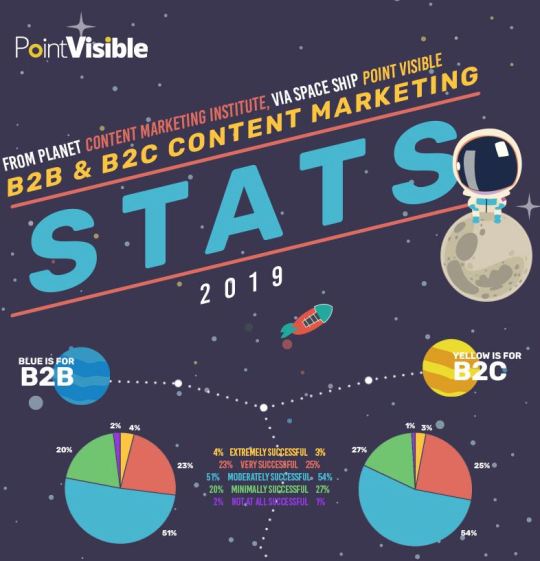
With 2020 on it's way, now is the perfect time to take a look at what parts of your content marketing strategy missed the mark in 2019.
Today we'll explore emerging trends in content marketing that could help us all to create more effective strategies for the new year.
So let’s take a look at five ways to improve your content marketing strategy in 2020.
1. Performance Monitoring
Tracking key performance indicators… it seems like a no-brainer, right?
Yet according to the numbers, only around 50% actually measured their content marketing return on investment in 2018.
What’s particularly worrying about this is that it implies that some organizations could have been placing their time, money, and human resources into lengthy campaigns that weren’t achieving the desired result.
In 2020, there must be a greater focus on monitoring campaigns and tailoring them as deemed necessary.
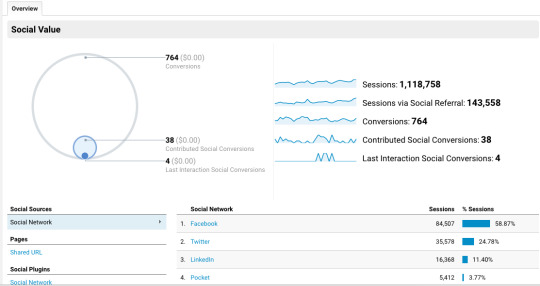
Perhaps the reason why 50% of marketers don’t measure their success is that they think of content marketing as being more of a science than an art. It’s easily done.
After all, we’re beginning to understand a lot more about what works, and what doesn’t. But content marketing is an art.
There’s no hard and fast rule about what marketers should do, and it’s natural that they’ll be a little trial and error involved. Next year, brands should be working to monitor, track, reflect, and adjust their campaigns.
Here are some ways that make it easier to keep a close eye on the overall success of your campaign:
Analyze audience behavior on your site. Are your readers clicking through to other areas of your website, or taking some sort of action towards conversion, such as making an inquiry? If not, it suggests that the quality of your leads isn’t quite as good as it could be.
Determine your value.Tools such as Google Analytics can be useful in determining the sales ‘value’ of each page and, more importantly, the content on that particular page. These tracking tools help you to create a route map, highlighting which pages are responsible for making SQLs convert.
SEO and content.Analytics tools can also be used to show which pages are receiving traffic, and which aren’t. This works to highlight any aspects of your content that aren’t reaching out to your audiences or to search engines, and could suggest an SEO business/audience disconnect.
2. Big Data
The term ‘big data’ is everywhere, and yet most marketers still don’t understand what it is, or how it can be applied to a content marketing setting.
In a nutshell, big data is just that: it’s a huge amount of collected and collated data that a business holds about its audiences. It’s related to pretty much every interaction that an audience member has with a business, from clicks to communications, and everything in between.
Big data is such a big deal because of what can be done with this data.
Big data goes hand in hand with artificial intelligence, as we begin to use this data to predict future trends and behaviors. Brands have been investing in big data since 2015, and it’s expected to grow even more by 2022.
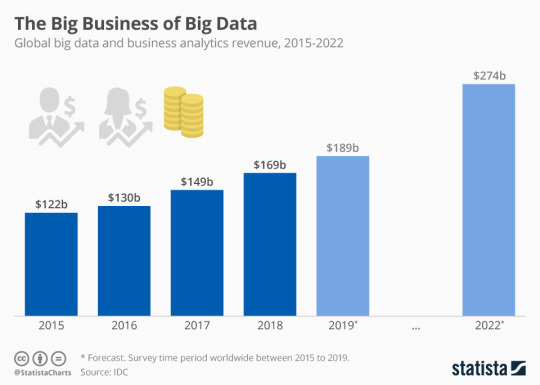
In content marketing data it holds the potential to do great things and is being cited as one of the key technologies to improve SEO ranking.
With the ability to collect, consolidate, and analyze customer information automatically, it’s possible that big data analytics could help marketers to identify trends and tailor their campaigns in response.
Big data is already being utilized by some of today’s most forward-thinking businesses. Mckinsey & Company estimates that around 44% of B2C marketers are using big data analytics to encourage better responses from audiences.
An additional 36% are understood to be using it to better understand customer behavior and generate more effective relationship-driven strategies. Overall, more than half believe that big data will be ‘essential’ for the marketing strategy of tomorrow.
Here are just some of the ways marketers could utilize big data in content marketing campaigns:
Use historical annual data to look at which sort of content attracts and engages with audiences the most throughout different times of the year. For example, long-form content may be more popular during winter months when people are spending more time indoors.
Similarly, we can use big data to gain a better understanding of what our audiences are searching for, and how aspects such as time of year can impact search terms. This enables marketers to tailor their SEO approach and create content that audiences want to see.
Big data can be used to look at associations between types of content. For example, it could show that audiences that are interested in this piece of content are also interested in that piece of content, which could be used to optimize the placement of internal links in articles.
3. CM Technologies
Content marketing technologies are becoming more widely available, and it is anticipated that, by next year, there will be even more accessible tools.
While 23% of brands are incorporating more technology into their campaigns. But don’t worry! We’re not talking full on robotics and complex artificial intelligence here. As Jacquie Chakirelis of the Great Lakes Science Center says, the role of AI and other new tech platforms is “blurry” and its impact on the relationship with the audience is not yet fully understood.
What we are talking about are automation tools which utilize aspects of AI to help marketers connect with the right people, generate topics of discussion that appeal, and really help content creators hone their skills.
According to the IDG report, ‘Technology Content Marketing 2019: Benchmarks, Budgets, and Trends’, some of the most commonly used CM technologies by today’s content marketers include:
Social media analysis tools
Email marketing software
Automation software
Workflow/project management software
Content optimization tools
Content management system (CMS)
Promotional tools
Chatbots
Artificial intelligence
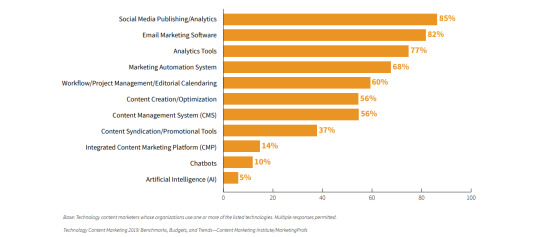
4. Real Time Content
The idea of ‘real-time’ is something that has already shown its value in the sales world. For example, real-time stock updates are already deemed to be the norm. Yet it’s something that hasn’t quite made its way fully over to the marketing sector.
This is all expected to change in 2020 as digital platforms begin to prioritize real-time, providing an increasing number of ways for content marketers to take advantage of this technology and engage with audiences during those ‘micro-moments’ when they want to buy.
Facebook Live is definitely the one to watch next year, especially with the updates that were rolled out in September 2019.
Facebook Live Video now allows marketers to ‘rehearse’ their content in advance to going live to test out interactive features and formats to ensure optimal levels of engagement.
In addition, the length of the broadcast has been doubled from 4 to a whopping 8 hours. Many of us watched this feature in use when NASA used their Facebook Live stream to show an 8 hour spacewalk!
Tools such as Facebook Live make it easier for marketers to tell their audiences a story, and make their content a little more interactive, which is something that’s hugely important right now.
Statistics show that only 52% of marketers use the concept of storytelling in their content. Surprising, given that the natural, inherent human process is to think in narrative, according to Marketing professor Susan Fournier.
In her Journal of Consumer Research paper, Consumers and Their Brands: Developing Relationship Theory in Consumer Research, she says that a ‘substantial amount of information stored in and retrieved from memory is episodic’. So why don’t you create content in an episodic way, too?
Here are some tips for getting real-time content marketing spot-on:
Set up Google Alerts so that you can stay on top of the latest trends, news, and announcements in your industry, and adopt an ABL (always be listening) approach.
Utilize commonly holidays and events into your content, such as holiday-themed content or content relating to widespread beliefs or trends with your target audience’s community.
As an alternative to tools such as Facebook Live, host a live Twitter feed during business events or throughout industry-related celebrations can provide valuable information for audiences.
Sales were once at the heart of communications, information sharing — and storytelling — is increasingly important at a time when consumers want to buy, but don’t want to be sold to. “I think most marketers still struggle with storytelling where the reader is the hero” says LinkedIn speaker Michaela Alexis.
5. Voice Optimization
By 2020, 50% of internet searches will be voice searches. which mean you’ll need to get in gear and start optimizing your content for voice.
While marketers have been optimizing content since Google’s Hummingbird update to coincide with the shift to Web 3.0, we’re still behind when it comes to voice specifically. At the Google I/O 2019 conference, keynote speaker Sundar Pichai, Google CEO, confirmed that 20% of all searches are already voice searches.
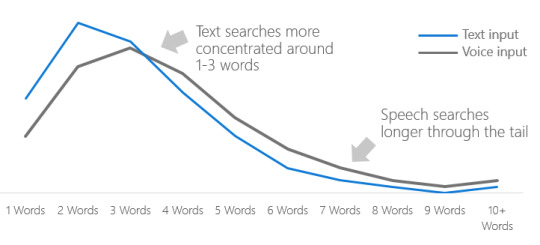
Both Web 3.0 optimization and voice optimization forces us to think more about how users are searching for content, and what they’re searching for. Long-tail keywords and conversational keywords will be more important than ever before next year, and marketers will need to consider speech patterns and localization when creating content.
Here are three tips for optimizing your content for voice searches:
Don’t think. Speak. Get vocal and take a closer look at what your audience would be using voice search for and how’d they be using it. Speak phrases as if you were your own audience.
Consider associated aspects that your audience may be including in their voice search. In a speech, it’s more likely they’d search for ‘restaurant in New York’ than just for ‘restaurant’.
Really think about context, and how a user’s voice search could be connected to other relevant searches. ‘Play center’, for example, could connect to other things to do with kids.
Summary
Here's a quick recap of five ways to improve your content marketing strategy in 2020:
Performance Monitoring
Big Data
CM Technologies
Real Time Content
Voice Optimization
Taking some time to consider these five aspects when planning your 2020 campaigns could not only help to make you a better content marketer, but actually help you to reach out to, and engage with, more audiences.
There is one thing that’s more important than anything else: solid documentation.
Here’s a statistic to make you laugh: 74% of B2C marketers and 78% of B2B marketers have a content marketing strategy. Great! But here’s the funny part… only one third actually think to write it down!
A content marketing strategy that’s being explored, but not documented, will likely end up being overlooked.
Explore the concepts above, try them, and document them. Create processes that will help you to achieve your goals, and which can withstand the demands of this rapidly changing environment.
About the Author

Deana Kovač is an internet marketing specialist at Point Visible, a digital agency providing custom blogger outreach services. In her free time, she enjoys listening to music and singing karaoke. Also, her day just can’t start without a hot cup of coffee.
Related Readings
Ecommerce Content Marketing: How To Create Content That Converts
77 Tremendous Tools to Make You a Content Marketing Superstar
6 Types of Content We Used to Grow a 250,000 Reader Blog
from RSSMix.com Mix ID 8230801 https://ift.tt/2PUYIIc via IFTTT
0 notes
Text
Can Edge Analytics Become a Game Changer?

One of the major IoT trends for 2019 that are constantly mentioned in ratings and articles is edge analytics. It is considered to be the future of sensor handling and it is already, at least in some cases, preferred over usual clouds.
But what is the hype about?
First of all, let’s go deeper into the idea.
Edge analytics refers to an approach to data collection and analysis in which an automated analytical computation is performed on data at a sensor, network switch or another device instead of sending the data back to a centralized data store. What this means is that data collection, processing and analysis is performed on site at the edge of a network in real time.
What is the hook?
You might have read dozens of similar articles speculating over the necessity of any new technique, like “Does your project need Blockchain? No!” Is Edge Analytics yet another one of such gimmicky terms?
The truth is, it is really a game changer. At present, organizations operate millions of sensors as they stream endless data from manufacturing machines, pipelines and all kinds of remote devices. This results in accumulation of unmanageable data, 73% of which will never be used.
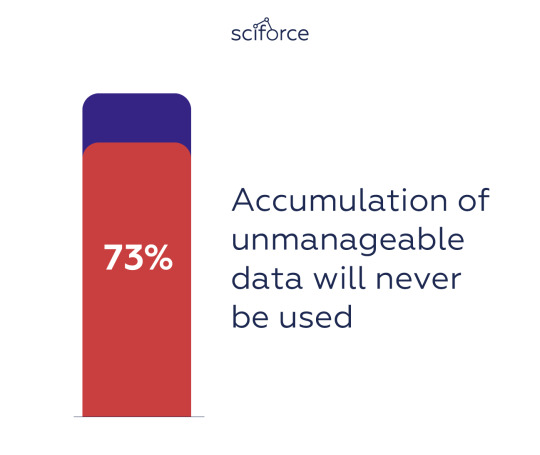
Edge analytics is believed to address these problems by running the data through an analytics algorithm as it’s created, at the edge of a corporate network. This allows organizations to set parameters on which information is worth sending to a cloud or an on-premise data store for later use — and which isn’t.
Overall, edge analytics offers the following benefits:

Edge analytics benefits
Reduced latency of data analysis: it is more efficient to analyze data on the faulty equipment and immediately shut it up instead of waiting for sending data to a central data analytics environment.
Scalability: accumulation of data increases the strain on the central data analytics resources, whereas edge analytics can scale the processing and analytics capabilities by decentralizing to the sites where the data is collected.
Increased security due to decentralization: having devices on the edge gives absolute control over the IP protecting data transmission, since it’s harder to bring down an entire network of hidden devices with a single DDoS attack, than a centralized server.
Reduced bandwidth usage: edge analytics reduces the work on backend servers and delivers analytics capabilities in remote locations switching from raw transmission to metadata.
Robust connectivity: edge analytics potentially ensures that applications are not disrupted in case of limited or intermittent network connectivity.
Reduce expenses: edge analytics minimizes bandwidth, scales operations and reduces the latency of critical decisions.
Edge architecture
The connected physical world is divided in locations — geographical units where IoT devices are deployed. In an Edge architecture, such devices can be of three types according to their role: Edge Gateways, Edge Devices, and Edge Sensors and Actuators.
Edge Devices are general-purpose devices that run full-fledged operating systems, such as Linux or Android, and are often battery-powered. They run the Edge intelligence, meaning they run computation on data they receive from sensors and send commands to actuators. They may be connected to the Cloud either directly or through the mediation of an Edge Gateway.
Edge Gateways also run full-fledged operating systems, but as a rule, they have unconstrained power supply, more CPU power, memory and storage. Therefore, they can act as intermediaries between the Cloud and Edge Devices and offer additional location management services.
Both types of devices forward selected subsets of raw or pre-processed IoT data to services running in the Cloud, including storage services, machine learning or analytics services. They receive commands from the Cloud, such as configurations, data queries, or machine learning models.
Edge Sensors and Actuators are special-purpose devices connected to Edge Devices or Gateways directly or via low-power radio technologies.

A four-level edge analytics hierarchy
Edge analytics going deep
If edge analytics is only paving its way to ruling the next-generation technology, deep learning, a branch of machine learning for learning multiple levels of representation through neural networks, has been already there for several years.
Will deep learning algorithms applied to edge analytics yield more efficient and more accurate results? In fact, an IDC report predicts that all effective IoT efforts will eventually merge streaming analytics with machine learning trained on data lakes, marts and content stores, accelerated by discrete or integrated processors by 2019. By applying deep learning to edge analytics, devices could be taught to better filter unnecessary data, saving time, money and manpower. One of the most promising domains of integrating deep learning and edge analytics is computer vision and video analytics.
The underlying idea is that edge analytics implements distributed structured video data processing, and takes each moment of recorded data from the camera and performs computations and analysis in real time. Once the smart recognition capabilities of a single camera are increased and camera clustering enables data collision and cloud computing processing, the surveillance efficiency increases drastically, at the same time reducing the manpower requirements.
Deep learning algorithms integrated into frontend cameras can extract data from human, vehicle and object targets for recognition and incident detection purposes significantly improving accuracy of video analytics. At the same time, shifting analytics processing from backend servers and moving them into the cameras themselves is able to provide end users with more relevant real-time data analysis, detecting anomaly behavior and alarm triggering during emergency incidents which does not rely on backend servers. This also means that ultra-large scale video analysis and processing can be achieved for projects such as safe cities where tens of thousands of real-time.
Experimenting with edge computers
Edge computers are not just a new trend, but they are a powerful tool for a variety of AI-related tasks. While Raspberry Pi has long been the gold standard for single-board computing, powering everything from robots to smart home devices, the latest Raspberry Pi 4 takes Pi to another level. This edge computer has a PC-comparable performance, plus the ability to output 4K video at 60 Hz or power dual monitors. Its competitor, the Intel® Movidius™ Myriad™ X VPU has a dedicated neural compute engine for hardware acceleration of deep learning inference at the edge. Google Coral adds to the competition offering a development board to quickly prototype on-device ML products with a removable system-on-module (SoM). In our experiments, we used them as a part of a larger computer vision project.
Real-time human detection
Human detection is a process similar to object detection and in the real world settings it takes raw images from (security) cameras and puts them in the camera buffer for processing in the detector&tracker. The latter detects human figures and sends the processed images to the streamer buffer. Therefore, the whole process of human detection can be divided into three threads: camera, detector&tracker and streamer.

As the detector, we used sdlite_mobilenet_v2_coco from TensorFlow Object Detection API, which is the fastest model available (1.8 sec. per image).
As the tracker, we used MedianFlow Tracker from the OpenCV library, which is also the fastest tracker (30–60 ms per image).
To compare how different devices work on the real-time object detection problem, we tested Coral Dev Board and Coral Accelerator for human detection from two web-cameras against Desktop CPU with Coral Accelerator and Raspberry Pi with the same Accelerator:
Coral Accelerator — Edge TPU Accelerator v.1.0, model WA1
Coral Dev Board — Edge TPU Dev Board v.1.0 model AA1
RaspberryPi — Raspberry Pi 3 Model B Rev 1.2
Desktop CPU — Intel Core i7–4790
WebCam — Logitech C170 (max width/height — 640x480, framerate — 30/1 — used these parameters)
As it turned out, the desktop CPU showed the lowest inference and the highest fps, while Raspberry Pi demonstrated the lowest performance:
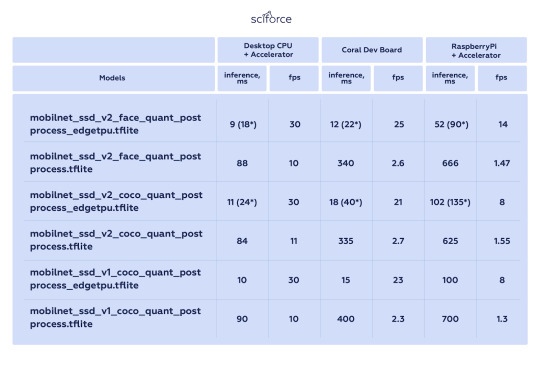
Chess pieces object detection
Another experiment addressed a more general object detection task, as we used this method for model conversion for Coral Dev Board and Accelerator and one of the demo scripts for object detection. We compared the performance of the Coral Dev Board and Accelerator against the Neural Compute Stick 2. For the latter, we used the openVino native model-optimization converter and this model+script.
Our experiments proved that the Coral Dev Board showed the lowest inference, while the Intel Neural Compute Stick 2 had the inference more than four times higher:

These experiments confirm the potential of modern edge devices that show similar performance with desktop CPUs.
Challenges and Restrictions
Deep learning can boost accuracy, turning video analytics into a robust and reliable tool. Yet, its accuracy usually comes at the cost of power consumption. Power balancing is an intricate task based on improving the performance of edge devices, introducing dedicated video processing units, and keeping neural networks small.
Besides, as only a subset of data is processed and analyzed in the edge analytics approach, a share of raw data is discarded and some insights might be missed. Therefore, there is a constant tradeoff between thorough collection of data offline and prompt analysis in real time.
Therefore, edge analytics may be an exciting area of great potential, but it should not be viewed as a full replacement for central data analytics. Both can and will supplement each other in delivering data insights and add value to businesses.
0 notes
Text
Empowering Auburn Hills with Advanced Industrial Automation Solutions – A Mark Read Track Initiative
Auburn Hills, Michigan – a city known for its innovation, manufacturing excellence, and technological growth – is fast becoming a hub for industrial automation. As local manufacturers continue to adapt to Industry 4.0 standards, the need for advanced, integrated, and scalable automation solutions is more pressing than ever. That’s where Mark Read Track steps in, offering cutting-edge Industrial Automation Solutions in Auburn Hills designed to revolutionize how industries operate.
Mark Read Track is an established leader in the field of automation, bridging the gap between traditional processes and digital transformation. With years of experience and a dedicated team of engineers and developers, the company is committed to delivering tailored automation systems that address real manufacturing challenges. From small-scale workshops to large-scale production plants, Mark Read Track delivers measurable impact through automation.
Their Industrial Automation Solutions in Auburn Hills include a comprehensive suite of services such as system integration, PLC programming, HMI development, SCADA implementation, and data-driven analytics. These services are not just about reducing manual labor; they’re about optimizing productivity, ensuring consistency, and preparing businesses for the future of manufacturing.
One of the key differentiators of Mark Read Track is its ability to customize automation systems based on specific industry needs. Automotive manufacturing, electronics, packaging, and food processing industries in Auburn Hills have already begun leveraging their solutions to gain real-time operational insights, reduce errors, and enhance machine efficiency.
At the heart of their strategy lies smart data integration. By connecting machines, sensors, and control systems, Mark Read Track enables manufacturers to make informed decisions in real-time. This not only cuts down on unplanned downtime but also leads to improved product quality and operational safety.
Moreover, Mark Read Track focuses on scalability. As businesses grow, their automation systems should grow with them. That’s why the company builds flexible platforms that can easily be updated, expanded, and integrated with new technologies. This approach ensures long-term value and adaptability in an ever-evolving industrial landscape.
Cybersecurity is another priority. As industrial environments become more digitized, the threat of cyberattacks rises. Mark Read Track incorporates robust security protocols into its automation systems to safeguard data, machinery, and intellectual property.
For companies in Auburn Hills looking to transition from traditional setups to smart manufacturing, Mark Read Track offers not just solutions, but partnerships. Their team works closely with clients from initial consultation through deployment and after-sales support to ensure every system performs at its best.
In an era where efficiency, speed, and precision define competitiveness, Industrial Automation Solutions in Auburn Hills are no longer optional—they are essential. And with Mark Read Track leading the charge, businesses in Auburn Hills can be confident they are embracing innovation with the right partner by their side.

#Traceability Software Great Lakes Region#Machine Vision Integration Great Lakes#Great Lakes Industrial Marking Solutions#Factory Monitoring Software Great Lakes Region#Lean Manufacturing Solutions Great Lakes#Automated Data Collection Systems Great Lakes#Industrial Traceability Solutions Detroit#Machine Vision Systems Detroit#Detroit Barcode Verification Services#Laser Marking Services Detroit MI#Production Management Software Detroit#Detroit Manufacturing Systems#product traceability software Detroit#industrial marking systems Detroit#Laser Marking Services Auburn Hills#Industrial Traceability Solutions Michigan#Barcode Verification Systems Auburn Hills#Machine Vision Systems Michigan#Auburn Hills Laser Part Marking#Industrial Marking Solutions Michigan#Traceability Software Auburn Hills#Turnkey Laser Systems Michigan#Auburn Hills Barcode Reader Solutions#Advanced Laser Marking Auburn Hills MI#laser marking systems#laser marking machine#laser part marking#uv laser marking machine#uv laser marking#dot peen marking machine
0 notes
Text
What's Missing From Your Content Marketing Tech?
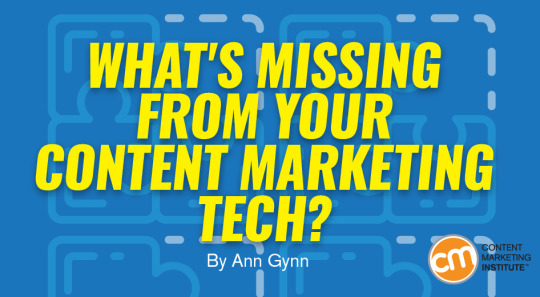
What’s Missing From Your Content Marketing Tech? Content marketing experts are a unique bunch When we asked Content Marketing World presenters about what’s missing in most content marketers’ tech stack, some waxed poetic, others imagined the possibilities, and others got practical, talking products and output That’s why we love them – a diverse group of answers means a diverse group of thinkers “Every content marketer is missing something from their tech stack Content marketing is a delicate, interconnected ecosystem – you have to have the right technology for each aspect of the process,” says Scott Spjut , assistant vice president, social and digital content, Fifth Third Bank To tackle this, we’ve divided this post into three categories: Tools you can use now General concepts for tools that exist or should exist Non-tech ideas that affect (or should impact) your content tech stack Whether you’re looking for a new tool, imagining tools to create (or wishing they existed), or think tech is overrated, these responses will resonate 13 content marketing tech tools you can use now For pulling third-party content A great news aggregator like Feedly – Michaela Alexis , LinkedIn speaker, trainer, and co-author of Think Video For identity, insight, governance A data lake to bring together data from web analytics, marketing automation, and CRM – and tie it to an identity, plus: LiveRamp – identity resolution work PathFactory – for content insight and activation Acrolinx – active content governance (Disclosure: those three are Velocity clients but we’re huge believers) – Doug Kessler , co-founder, Velocity Partners For indexing and security Index Checking is a good way to see whether a page is indexed or whether you’re blocking it (sometimes developers forget to remove a noindex used during a redesign) SSL Check is helpful for sites that move toward HTTPS but have page elements like images that aren’t in secure directories The tool discovers the pages with issues.. – Mike Murray , president, Online Marketing Coach For Instagram scheduling Planoly for scheduling out Instagram posts – Griffin Thall , CEO and co-founder, Pura Vida Bracelets For real-life talk Talking to customers, where the tool involved is called the telephone Of course, one could also use Skype, Zoom, and related tools I like to build a complete picture of my customers, including aspects of their jobs (or lives) that extend beyond the use of my products or services – Dennis Shiao , consultant, Dennis Shiao Consulting For all to see Microsoft Excel or Tableau – a platform that gives marketing visibility into the other business units, such as sales and insights – Christine Michel Carter , creator, Mompreneur and Me For project management I use Trello as a workflow and project management tool Every project needs a tool or space that is a single point of truth – here’s the latest version, here’s all the related commentary, and here are the next steps – as at-a-glance as possible. – Jonathan Crossfield , chief consulting editor, Chief Content Officer magazine 21 content tech tool concepts Artificial intelligence I see marketers shy away from AI-powered marketing technology and startups until the adoption is higher. But now is the time to embrace the speed, insights, and agility AI-powered technology has to offer and get ahead of competitors – Jeff Coyle , co-founder and chief product officer, MarketMuse Bots-plus Co-bots are technologies designed to work best when paired with humans’ empathy, intuition, and judgment In contrast, black-box robot technologies are hard to explain or learn. Once set up, they tempt people to stop thinking and work on autopilot That’s why robots can be dangerous – George Stenitzer , founder and chief content officer, Crystal Clear Communications Content management Marketing operations need to consider a solid CMS Along with providing a place to document and track workflow of content production , setting up a CMS with the proper information to track for each piece of content developed can provide insight into the activity of published content, as well as a road map to content planning for the future – Pamela Muldoon , campaign and content strategist, The Pedowitz Group Organization and collaboration I don’t think there are enough brands focused on the efficiencies a CMP can bring to your organization Being more organized and collaborative helps you create better content – Zari Venhaus , director, corporate marketing communications, Eaton CMS focused on sales Sales-oriented content management systems that allow for appropriate seller tailoring – Seleste Lunsford , chief research officer, CSO insights, research division of Miller Heiman Group Texting Given the adoption of messaging by people (consumers and business professionals), a text messaging platform that is owned will be important for conversational marketing programs in the near term And you’ll want it to be yours, rather than Facebook Messenger – grow your own opt-in list/audience Chat is great. SMS/MMS can take it up a level when done well – Ardath Albee , CEO and B2B marketing strategist, Marketing Interaction Inc Away from the internet Offline sales or traffic attribution is a big investment, but we are too far into the data-driven future to still be guessing at how we place our media or how we evaluate our digital campaigns Walk-in traffic verification or look-back attribution matching can help us know what really drove the number we care about most: sales! – Jessica Best , vice president of data-driven marketing, Barkley All-in-one engagement analytics One-stop engagement platform that would pull in all engagements, regardless of where they occur, social, web (own), web (third party – think guest posts), etc would give the content creator a perfect picture of their most engaged fans – Tom Martin , president, Converse Digital All-in-one project management A tool that truly integrates all channels and workflows – Christoph Trappe , chief content officer, Stamats Business Media Process analysis Something that’s missing way too often is a tool that offers the ability to measure and optimize the process of content marketing It might be a project management tool , an Agile tool, or just a good old-fashioned whiteboard, but having access to basic efficiency data is shockingly rare for content marketers We need to know how long things take, where the bottlenecks are, who’s holding us up – pretty much just a snapshot of how our operations are going Without that basic level of information, we’re stuck when it comes time to try and figure out how to do more in less time – Andrea Fryrear , Agile marketing coach and trainer, co-founder, AgileSherpas Audience knowledge Audience data collection and analysis to drive story topics, execution, and distribution are needed Marketers often don’t have access to audience insights and are thus engaging in guesswork about what will resonate with their intended audience At The Washington Post, due to our state-of-the-art tech and audience surveys, we are fortunate to have access to data about audience behavior and interests We then use this data to inform the entire creative and promotion process, from selecting the right story topics to type of content to distribution strategy It’s all about the marriage of science and art Our program for Destination Canada illustrates this We found that people who are engaging in travel content are also reading a lot of food and history content This guided our decision to focus the story on a chef traveling to Canada to learn about his culinary roots – Annie Granatstein , head of WP BrandStudio, The Washington Post Reverberation Without a doubt, the ability to know what content is resonating, either by individual channel or by owned media content This is a giant blind spot I experienced for myself, and one of the reasons I wrote software for Trust Insights to fix it – Chris Penn , c o-founder, Trust Insigh ts Full-picture understanding More and more marketers express a desire for a smarter, more in-depth understanding of their metrics , but most have not invested in the tools (and customizations) to bring all their data into one cohesive system If your information is in three places and you can only look at them in PDF form, are you really getting the full picture? Can you answer the important questions your organization needs to answer? – Zontee Hou , co-lead of consulting, Convince & Convert Buyer journey analysis Few content marketers have the technology in place to accurately implement multi-touch attribution and understand all the points of contact in the buyer’s journey And that’s a bummer because it means we are too often giving too much or too little credit to pieces of content in our library and making decisions based on partial data – Erika Heald , marketing consultant, Erika Heald Consulting Efficient and effective distribution Despite tagging and other methods of ordering content, I feel there is a huge need for a platform that can sort and deliver the right content at the right time This (likely AI) platform would access all your content (blogs, podcasts, videos, whitepapers, etc) organize and sort it, and then deliver the perfect piece of content to the sales professional depending on who they are engaging on what level of the buyer’s journey I spend far too much time sorting through my own blog and YouTube channel to find exactly the right article to deliver when I see a buying activity online – Viveka von Rosen , chief visibility officer, Vengreso Listening Social listening , specifically for smaller companies with smaller marketing budgets Social listening is a great tool not just for understanding the sentiment surrounding your business but also for being able to act on that, including creating the right kind of content In the rush to create and to publish, this is something that can get missed – Dan Hatch , founder, Typeset Script crafting Script creation is important if you’re doing video and animation work because crafting good content for the visual medium is different than just straight-up content writing – Ben H Rome , manager, marketing and communications, AIHA Idea generation Content marketers need tools to help them understand what content to create – Michael Brenner , CEO, Marketing Insider Group Dollars and sense A tool to quantify the ROI of content It’s important to ensure the back-end is integrated so that you can see the content the sales team uses and the content prospects read – Pam Didner , B2B marketing consultant and author, Effective Sales Enablement Revenue effect I think most marketers are missing a tool that helps measure the impact of their content on the revenue they generate… what tool is it? Unfortunately, I don’t think that tool exists – Andrew Davis , author, The Loyalty Loop, Brandscaping, and Town Inc Content value chain I haven’t found a tool to measure the whole value chain of content marketing as it relates to business goals We’re awash in data and analytics but I’ve found nothing that allows you to measure the activity and results in your content marketing ecosystem against business goals – Sarah Mitchell , founder, Typeset A few less-techy thoughts Measure for now Are your KPIs still stuck in the sales funnel developed in 1924? Or are you considering the modern buyer’s journey ? (Today’s buyer has been described as “adlergic” and many are reading blogs before interacting with a sales rep..) Make sure you’re gauging content marketing success with the right tools and with KPIs that fit today’s buyer, not yesteryear’s – Julia McCoy , CEO, Express Writers Connections Authentic engagement is the tool that is most often lacking in the content marketing effort. – Yadin Porter de Leon , global executive content strategist Universal buy-in Most of us have the tools we need The struggle is getting cross-functional buy-in to use those tools in a collaborative and effective way – Amanda Changuris , manager, social media marketing, AAA – The Auto Club Group Look before you buy (again) Instead of looking at what’s missing from your tech stack, look at what you’re using and how you’re using it first More isn’t always the answer And remember even the biggest, best platforms won’t work miracles on broken content – Anna Hrach , strategist, Convince & Convert What content tech do you want? If you could sit at the drawing board with content tech innovators, what would you have them design? Let us know in the comments Or if you already have the perfect content tech tool, we’d love to share the good word Add it to the comments HANDPICKED RELATED CONTENT: Read the full article
0 notes
Text
Skylum Doubles Down on AI Image Enhancement in Luminar 4 Photo Editor
We’ve written a lot about how much Adobe is now relying on the power of its Sensei AI platform, but in most cases Adobe is using it for tagging, selecting, and other tasks that help accelerate creative workflows, and not for pure image enhancement. Skylum, makers of the Luminar image editor and Aurora HDR processing tool, have in contrast gone all-in on AI-powered image enhancement. This is particularly clear in Luminar 4 ($89, available for pre-order via a special offer). I’ve been using a pre-release version for several weeks now, side by side with tools from Adobe and others, and can report that it provides an intriguing option for those looking to get results quickly without giving up the power of a full image editor.
Luminar Isn’t Photoshop or Lightroom, It’s Some of Each
Luminar fits in an interesting space somewhere between Photoshop and Lightroom. It has a non-destructive, slider-based, set of tools that work on a variety of image formats, like Lightroom. But it also has support for Layers, like Photoshop. However, you can’t go wild adding graphics and text to your image, or creating content from scratch as you can in Photoshop. And while it does have a Library module, it is not much more than a file browser with an option to create collections of images called Albums. So you can’t do all the powerful tagging and searching that you can on a Lightroom catalog (then again, you also don’t need to worry about maintaining one).
Once you’re used to adding folders to your Library, the folder system works pretty well. However, one thing that drove me nuts about the Library module is that there doesn’t seem to be any way to put basic information about each photo on its thumbnail in the Library. I get why a pretty view of your images is a lot of fun, but if you need to do serious work you often want to see the filename, date, or other key data while you are browsing. You can put information in a sidebar, but as far as I can tell it is only displayed once you click on an image.
AI Image Enhancement You Can Control
For those familiar with the nagging prompts provided by Google Photos suggesting semi-magical Automatic enhancement of your images, the concept of AI-driven image enhancement isn’t new. But features like Google’s are black boxes and very hit-or-miss about whether they will work for a specific image. Or indeed, whether Google’s computer’s creative vision for the image is the same as yours. Luminar 4 uses AI to provide the underlying framework to allow you to apply and customize a wide variety of types of enhancements, and even use contributed presets that it calls Looks.
The flagship enhancement is called, simply enough, “AI Image Enhancer.” Using it on a variety of images I found that it does an excellent job of making images more pleasing. Until now, I’ve found that DxO’s PhotoLab had the best-automated image process for 1-click image enhancement, but Luminar 4 definitely provides a competitive alternative. In addition to some hard-to-argue-with standard improvements, the AI Image Enhancer also tends to make colors richer and scenes warmer. That is a great starting point, but not for everyone or every image. It is easy to dial the effect back or click through some of the dozens of other Looks that are provided with Luminar 4.
Luminar 4’s AI Image Enhancer did in a few seconds what would have taken me a few minutes in Photoshop.
Looks are organized into groups, including Essentials, Landscapes, Street, Portrait, Lifestyle, Dramatic, Aerial, User-defined, and downloaded. Flipping through them reminds me a bit of using an HDR program on a set of bracketed images. There is usually one that looks pretty good. But if it isn’t quite what you want, you can use the editing power of Luminar to tweak it to your heart’s content. You can change the slider settings on typical image adjustments, or even add additional layers, with many of the same capabilities as you’d find in Photoshop.
I found that the Autumn Colors preset did a nice job of warming up images taken under harsh light, like this one of elephants at a watering hole in southern Botswana.
In addition to a wide variety of typical image editing tools, there are also specific tools for AI Accent, AI Sky Enhancer, and AI Structure. Now, the buzzword AI is being applied to everything, so it’s not always clear in what way each of these tools uses carefully trained neural networks or other technologies that fall under the AI rubric. But, of course, it doesn’t really matter as long as the results are what you want. In my testing, I found the AI-powered filters did a surprisingly good job of creating more pleasing versions of the images I fed them. Like with many image enhancement tools, it’s easy to overuse them and create images that are gorgeous but give themselves away as being better-than-real, so moderation is called for.
AI Sky Replacement
One gripe common to anyone who photographs outdoors is that gorgeous skies often don’t show up when you want them to. Compositing an image taken from a specific place with another of the sky from the same place on a different day is something of a time-honored tradition (although of course, the result is no longer a true photograph.) In any case, the idea of automating the process is intriguing.
A screenshot of my original image from the North Rim of the Grand Canyon with a plain blue sky
I was able to replace the solid blue sky of the image with one of the preset versions provided by Skylum.
Unfortunately, the first release of Luminar’s Sky Replacement only used their preset skies. In my mind that crosses the line from some type of photography to graphic art. I was pleased that they have now enabled the capability to use your own sky images. There is a bit of a trick to it though. It isn’t as simple as taking a second image of the same scene and letting Luminar do the heavy lifting. You need to deliberately shoot images composed of just the sky for the replacement to work (or crop an existing image to just the sky). That’s not the end of the world, but aiming up at the sky isn’t always automatic, and doesn’t always give you the perspective you want. So creating custom skies takes a little getting used to.
To use your own sky image you need to provide images that are entirely sky, not just images similar to your original that have a different sky. As an experiment, I used a sky from a sunset over Lake Michigan.
Is Luminar 4 the Image Editor for You?
My biggest gripe with Luminar 4 is that the company seems to have paused development of its cataloging system in favor of concentrating its efforts on image enhancement tools. So if you’re looking for something to replace Lightroom for cataloging your images, you’ll probably find the Library module of Luminar too limited. If you wind up keeping Lightroom as your cataloging system, but still want to take advantage of Luminar’s features, the company provides a plug-in for both Photoshop and Lightroom Classic, which is installed automatically when you install the main product.
Luminar 4 is available for pre-order prior to when it ships on Nov. 18 for $89 in a special offer that includes a variety of Look presets and a 1-year SmugMug membership.
[Image credit: David Cardinal]
Now Read:
Hands On With Adobe Photoshop and Premiere Elements 2020
Hands On With CyberLink Director Suite 365
Adobe Unleashes Flurry of Creative Cloud Features at its MAX Event
from ExtremeTechExtremeTech https://www.extremetech.com/computing/301550-skylum-doubles-down-on-ai-image-enhancement-in-luminar-4-photo-editor from Blogger http://componentplanet.blogspot.com/2019/11/skylum-doubles-down-on-ai-image.html
0 notes
Link
The promise of big data and artificial intelligence is everywhere. writes Jon Wells, VP customer solutions, Networked Energy Services. One almost gets the impression that there is no problem that cannot be solved with these new technologies. The answer to everything is ‘big data and artificial intelligence’.
Big data and artificial intelligence is the answer
This article was originally published in Smart Energy International 4-2019. Read the full digimag here or subscribe to receive a print copy here.
Open a web browser and you see advertising tuned to your latest online shopping. Turn on the TV and you see advertisements about how our leading IT providers are using big data and artificial intelligence to address social, economic and environmental challenges. Two extremes of direct application of big data and artificial intelligence.
The tools used to derive timely, actionable insight to both the biggest and the most mundane challenges have certainly hit the mainstream. Using these tools has direct application to the smart grid. They can be used to increase reliability, improve operational efficiency, reduce energy loss, increase fair energy supply by reducing fraud and theft, identify illegal use of energy, enable other green energy initiatives such as distributed generation, energy storage, and electric vehicles, and focus restoration by sociological and business priorities.
The piece which is often left out of all the buzz is where is all this data coming from and how it gets to the big data and artificial intelligence platforms. We know it ends up in data lakes and data marts, but where is this data created, how does it get to the systems that can create the value from it, and how do we know that it is secure as it makes this journey? And, then, how is this managed in a smart grid?
The smart grid is the answer
Initiatives like the Clean Energy Package in Europe and the proposed Green New Deal in the US are driving the Energy Transition and putting the focus onto the smart grid to achieve the improvements above. Similarly to big data and artificial intelligence, whenever the question concerns energy efficiency, the answer seems to be ‘the Smart Grid’.
A smart grid is generally split into three segments: the high-voltage, medium-voltage and the low-voltage. The high- and medium voltage pieces are highly visible – they are major engineering projects and come with sophisticated communications, security and management capabilities in-built.
Getting information to feed the big data and artificial intelligence platforms is no great challenge here because the infrastructure is already there.
The low-voltage grid is more challenging – the equipment is highly distributed, often antiquated, unmonitored and unmanaged, and mostly ‘passive’ from an IT perspective.
It has little or no mechanism to share information back to these big data and artificial intelligence platforms that are waiting for it. As such, this represents a suboptimal use of major investments by DSOs.
This is unfortunate because it is in the low-voltage grid that the energy transition, driven by the Clean Energy Package and other green energy and conservations initiatives, is going have the largest impact over the next decades:
• Increased distributed generation
and storage – using residential-scale equipment to generate solar, wind and hydro energy, store locally and feed-back into the local low-voltage grid • Community energy and micro-grid – balancing the supply of energy within a community to minimise the demand on external centrally generated energy.
Both of these require a low-voltage grid that is highly optimised, and which can be dynamically switched through modes of operation to maintain that optimisation as demand and generation changes.
Thus the problem becomes how to create information about the performance of the low-voltage grid, and then communicate that, securely, to the ever-hungry maws of the big data and artificial intelligence platforms.
Internet of Things is the answer
Connection of everything in the low-voltage grid to ‘the Internet of Things’ could be the answer.
Of course, ‘everything’ is really limited to those things with enough IT capability to connect and share information, where the coverage provides the service and where it is technically and economically viable to use the service at the volumes required. That is fine in the high- and medium- voltage grids but still has challenges in the low-voltage grid, where many millions of consumers and their equipment need to be connected and managed.
Energy suppliers need to consider the costs of deploying IT-enabled equipment deep into the low-voltage grid, the costs of physically installing SIMs and associated SIM management, and the costs of monthly subscription for connecting to millions of end-points to collect many gigabytes (or even terabytes) of data each day.
Energy suppliers also need to consider the technology capabilities – there are several applicable network technologies, which can be used (NB-IoT and LTE-M being the most common).
These are wireless technologies, but it is also possible to connect through powerline communications to back-end systems which are Internet-enabled. This approach does not involve a subscription fee, but is dependent on distances, quality and noise-levels of the power cable, and, so, like wireless communications, needs to be considered carefully.
Smart meters are the answer
So, the ability to connect to all low-voltage devices is a potential challenge – let’s look at the devices themselves and see if they are the answer.
The all-pervasive IT-enabled equipment in the low-voltage grid are smart meters. These come in various shapes and sizes, ranging from the barely-smart through to the truly smart, and are generally deployed at the edges of the low-voltage grid. Barely-smart meters are typically able to communicate low-volumes of ‘basic’ consumption information relatively infrequently, and simply exist to provide automated billing.
At the other extreme, the truly-smart can be configured dynamically to report back on a wide range of voltage and power quality metrics, on a regular basis.
Of course, the truly-smart meters tend to attract a premium price tag that needs to be considered, when the DSO is also assessing their medium- and long-term investment strategy and business case. The reality is that, all too often, the DSO is under pressure to follow a policy of cost reduction, and this drives some to the barely-smart version of the smart meter. Unfortunately, these cannot actively participate in feeding the demands of big data and artificial intelligence, and so represent a lost opportunity to leverage the investments made in these platforms.
In any case, the smart meters generally only provide information about the customer service points and (sometimes) the substation transformer. This still leaves a big gap of coverage – effectively, the power cabling and associated distribution devices.
However, some of the truly-smart meters are addressing this space to provide an end-to-end view of low-voltage grid performance.
Don’t look for the silver-bullets – practical solutions are needed
Putting aside the buzz around big data and artificial intelligence, Smart Grid and Smart Meters, there are practical solutions to presenting the volumes and types of information that are required to form timely insight for energy and operational efficiency and sociologically balanced green and fair energy programmes.
Where will information come from?
The low-voltage grid data needs to be created somewhere. Dedicated monitoring systems can be deployed, but they are often too expensive to be deployed as a ‘blanket’ – rather they are deployed in specific known problem areas.
The most prevalent source of information across the low-voltage grid remains smart meters. The truly-smart meters allow large volumes of voltage and power information to be reported back to the DSO with enough frequency that they can spot trends, detect outages and short-term inefficiencies, gain insight and take action.
DSOs should look at their smart meter procurement policy and be confident that smart meters will justify their big data and artificial intelligence investments and generate timely and actionable insight.
Where barely-smart meters are being deployed, DSOs will find themselves without detailed information of the low-voltage grid, be unable to feed big data and artificial intelligence platforms and be unable to adapt to the changing demands in the low-voltage grid.
Communication of volumes of data
The volume of data quickly scales up when one considers the millions of end-points that will have a smart meter; potentially to many gigabytes and even terabytes of data per day.
The volumes and the subscription cost will challenge the standard wireless ‘Internet of Things’ connectivity model. Communications of at least some of this payload over PLC will significantly reduce the cost and data volumes using wireless and will allow the best of both technologies to be leveraged by the DSO.
A hybrid model of PLC and wireless will ensure both volumes and subscription cost remain manageable, and the data can be carried to the ever-hungry maws of the big data and artificial intelligence platforms.
PLC has received bad press over the last few years, creating an impression that it is old technology. In fact, there are truly smart meters based on PLC that employ the highest quality protocols to achieve high information rates, even in the most challenging network environments.
Robust
Some truly-smart meters extend these options by providing connectivity to physical networks, which terminate at the home, the multi-dwelling unit or in the street. In these cases, the standard communications provided by the smart meter is augmented, and either used to carry more information more frequently, or to provide a back-up in the event of one of the communications mechanisms failing.
The latter resolves the problems of having ‘holes’ in the big data. Some DSOs can even leverage fibre infrastructure provided by government programmes or their own investments and diversifications.
Secure
A lot of privileged information about the consumers and about the DSO is transported.
The data lakes and data marts are highly secure, but the source of the data in the low-voltage grid and the communication through the low-voltage grid also needs to be as secure.
The built-in security features of the smart meters, the wireless and PLC communications needs to be carefully assessed so that the information shared with the big data and artificial intelligence platforms isn’t, accidentally, shared with the cyber-criminal fraternity. Again, typically, this is where the barely-smart meters are lacking, and so justify an extra careful assessment before selection.
Not just electrical energy
Truly-smart meters tend to have additional communications capabilities in-built to allow connection within the consumer’s residence.
This can be used to either connect to other WAN communications, such as the local ISP or community fibre infrastructure, in-home devices or to gather information from other utility meters such as gas and water. All three utilities – electricity, gas and water – are scarce resources, and can be exposed into big data and artificial intelligence platforms via the truly smart meters.
Not just end-points
Finally, the flow of energy within the lowvoltage grid is as important to understand as the energy provided by and delivered to its end-points. The latest truly-smart metering solutions use their own on-board analytics to derive more information about how energy flows within the low-voltage grid, allowing far more fine-grain business insight to be generated and the guesswork to be taken out of what is happening between the substation and the consumer. SEI
https://ift.tt/eA8V8J
1 note
·
View note